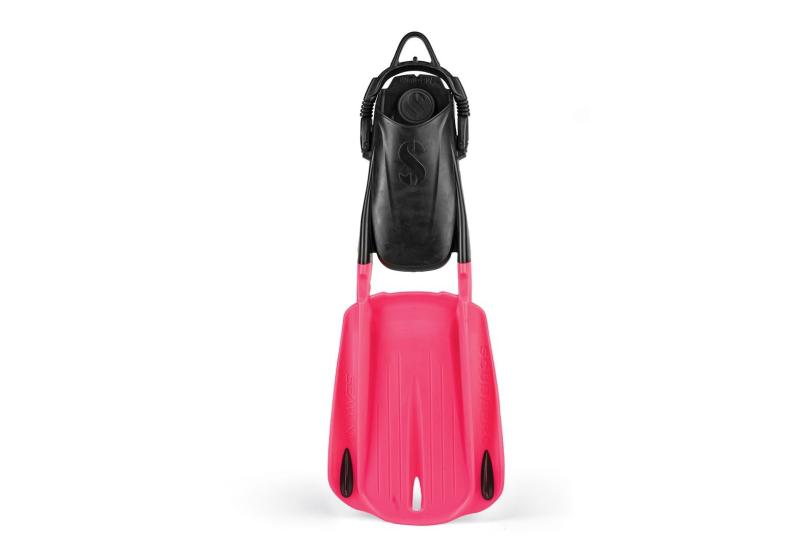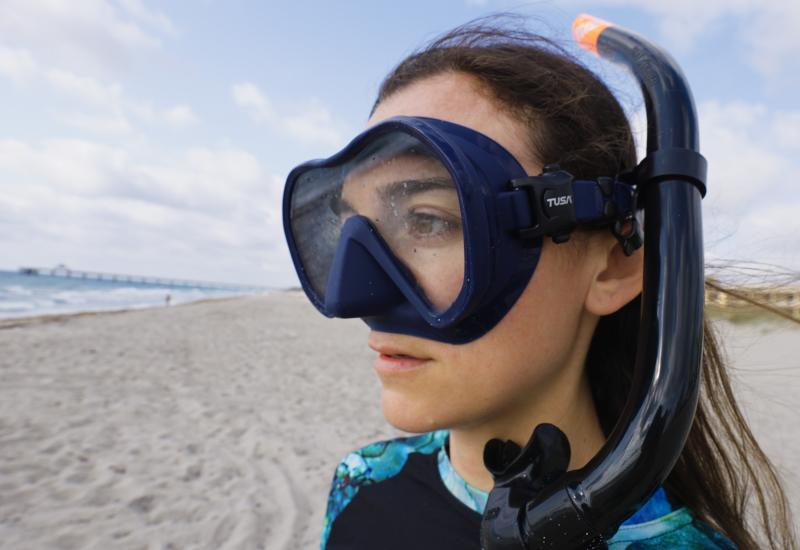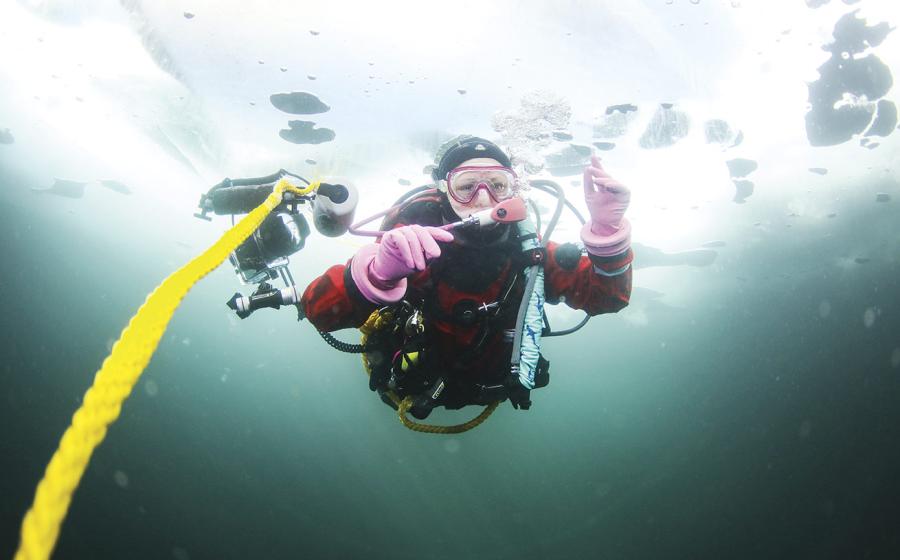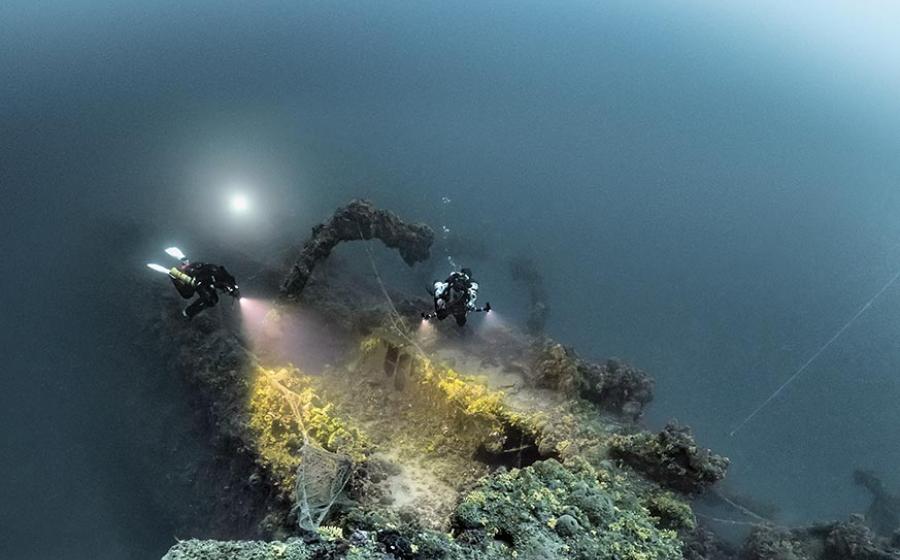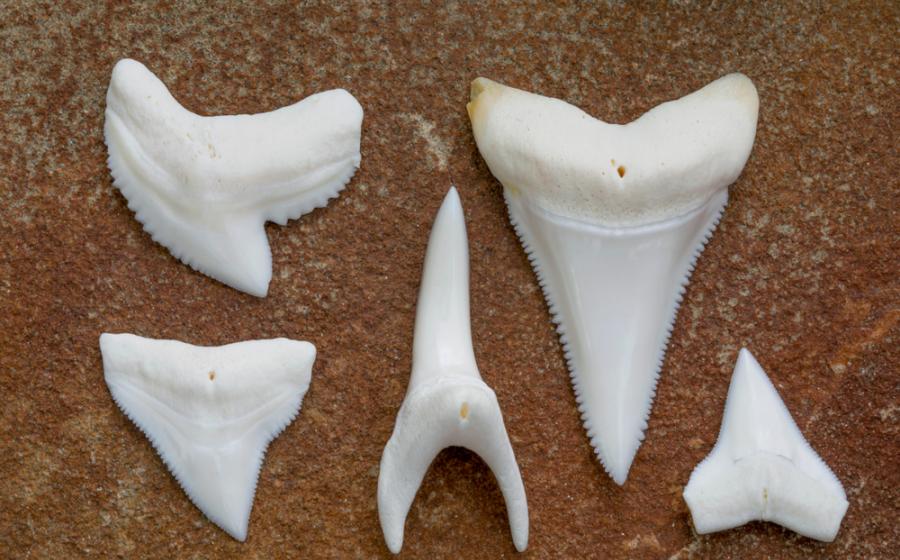Fin Fight
| 2004 Fin Test: Behind the Scenes Scuba Lab: 2004 Fin Test (PDF--76k) |
November 2004
By John Brumm

On a balmy afternoon in May, 12 divers loaded down with luggage congregated in Curaçao's Hato International Airport. Scuba Diving's volunteer dive team, called to arms for another round of fin testing, shared hugs and backslaps pent up from a year's separation.
The eight men and four women hailed from California to Virginia, Montana to Texas. Back home, they were computer consultants, software developers, chemical engineers, dive instructors, energy policy analysts, account executives and small business owners. But for the next week they would be test divers. Their mission: to see which of this year's new scuba fins had the right stuff.
By the time the test team arrived at Habitat Curaçao, Anne-Marie Vermeer and the crew at Easy Divers, the resort's dive operation, had our seven crates of fins and test tools cleared from customs and safely stored in her dive training classroom. The dive boat was gassed up, and down in the fill shed both air and nitrox tanks stood ready, waiting for us to get busy.
So that's what we did. While the test divers organized their gear, the Scuba Lab staff laid out the slalom and efficiency courses in the shallows just off the resort, then loaded fresh batteries into the digital underwater speedometers, double-checked stopwatches and strapped waterproof test sheets to underwater slates. By the time the team was assembled on the dive dock, we were ready to collect some data.
Each morning for five days, team members immersed themselves in rigorous speed, slalom and efficiency course runs. Then, after a quick soak in the pool and a hot lunch, they loaded onto the dive boat and headed out to evaluate the fins on afternoon reef dives. By week's end, the team had invested 240 diver hours in morning speed, slalom and efficiency tests and completed 160 afternoon ergo dives. In all, our divers generated more than 225 pages of speeds, times, scores and comments, demonstrating once again that nobody consistently collects as much data, on such a wide variety of fins, as Scuba Lab.
2004 Test Observations
||
|---|
|

)|
|

|
|

|
Full-foots are not always fastest. In past years, full-foot fins dominated the speed runs. This year, for the first time, the fastest fin in all speed runs was an open-heel model. While a form-fitting full-foot pocket can play a major role in a fin's efficiency, it doesn't guarantee the gold.
Split fins still rule the seas. Although a few paddle fins are closing fast, split fins still reign supreme when it comes to overall performance--the combination of speed, maneuverability, efficiency and ergonomics as measured in our tests. This year, of the eight Testers' Choices awarded in both open-heel and full-foot categories, six went to split fins.
Speed equals performance. While raw speed isn't everything, our tests clearly show it's a good indicator of a fin's overall performance. For example, the three fastest fins on this year's speed course were also the champs on the slalom and efficiency courses.
We need better buckles. Never in the recent history of fin tests have we had so many buckle disasters, including pins coming out at depth, spring-loaded strap adjustment buttons falling apart on the dive boat and straps snapping on the swim step. And these are new fins. Expensive new fins. A broken buckle or strap can bring a dive to a screeching halt. That's why Scuba Lab thinks fin manufacturers should include at least one spare strap/buckle assembly with each pair of fins they sell.
Behind the Scenes at Fin Test 2004
Fins on. Fins off. Repeat. The Habitat Curaçao dock (top) was fin test central for speed, efficiency and slalom course runs. Test diver Donald Victorian (middle left) measures his top sustained speed with a digital underwater speedometer. On reef dives (middle right), our volunteers evaluated the ergonomics of fins in real-world conditions and (bottom) managed to have some fun, too.
See more photos of the fin testers at work and at play in an exclusive behind-the-scenes report from Fin Test '04. Visit www.scubadiving.com/200410_scubalab_fintestbts.
Open-Heel Fins
2004 Testers' Choices
These six top performers in the open-heel category proved to be fast, maneuverable, stable and capable of quick acceleration.
Apollo Sports Bio-Fin Pro XT/C-Series
||
|---|
|

|
| Apollo Sports Bio-Fin Pro XT/C-Series|
Various models of Apollo's Bio-Fin Pro split fins have dominated Scuba Lab's fin shootouts since 1999. This year it's the Bio-Fin Pro XT/C-Series. The undisputed king on the flutter-kick speed course, the fin also smoked the competition on the dolphin- and frog-kick runs. It was also the fastest fin around the slalom course, and earned the second-highest score for ergonomics. Add it all up and you get one-half of a two-way tie for 2004's best overall open-heel fin.
The XT is identical in appearance to other Bio-Fins. Where it differs is in the stiffness of its blade. Designed for divers who prefer a bit more "feel" to their fins, the XT has a durometer--or stiffness level--of 75, compared to 70 for the new Bio-Fin Pro Yellow (see following review) and 65 for the Bio-Fin Pro Black, one of last year's top open-heel fins.
The C-Series designation refers to the XT's new commercial-grade straps, with built-in stainless steel coil springs and rugged rubber grips. They through-bolt to backing plates on the foot pocket and appear virtually bulletproof. Test divers loved them.
The only complaint about the XT/C-Series was that it's only available in three sizes, and they tend to be cut on the large side. This wasn't a problem for the male test divers, but a few of the women felt left out of the fun when they couldn't find an XT that fit.
Test Diver Comments "This fin is a rocket. Love the strap ... Easy to make small maneuvers. A must-have fin for videographers and photographers ... Great fin! This spring-loaded strap is a revolutionary breakthrough. Very comfortable foot pocket."
Apollo Sports Bio-Fin Pro Yellow
||
|---|
|

|
| Apollo Sports Bio-Fin Pro Yellow|
Like its macho XT cousin, the Bio-Fin Pro Yellow is a bonafide speedster, and a real neck-snapper off the mark. One of only two fins rated Excellent in the power vs. stress ergo category (the other was the XT), this is also the only fin test divers rated Excellent for acceleration--the blade is not as stiff as the XT so it tends to have a livelier snap. Stable at high speeds and quick and nimble on the reef, this pliable fin racked up the highest total ergo score in this year's shootout. Combined with a second-best time on the slalom course and the fastest time on the efficiency course, the Bio-Fin Pro Yellow earned the same total overall score as the XT and therefore shares the title of best overall open-heel fin of 2004.
The vibrant color is intended for divers and guides who want to be noticed. And like all Bio-Fin Pros, the Yellow is made of 100 percent natural rubber, which not only contributes to its performance, but also makes for an extremely comfortable foot pocket. The fin comes in an additional smaller size that female test divers really appreciated.
Test Diver Comments "Powerful, yet comfortable--it virtually form-fits to your foot ... Zero resistance at high speeds. A real go-fast fin ... Great nonskid--these fins aren't going anywhere on deck ... Great pickup from a dead stop ... A fine choice for sprinting after wayward barracuda."
Atomic Aquatics Reef Red
||
|---|
|

|
| Atomic Aquatics Reef Red|
This latest version of Atomic's sturdy SplitFin gets its name from the bright red flexible panels on its split blade. According to Atomic, the fin's base material is similar to last year's Liquid Blue, but has an added ingredient that increases elasticity over previous SplitFins. It's also lighter than its predecessors.
Like earlier SplitFins, the Reef Red sports a longer-than-average blade--the longest split fin blade in this group. In spite of its length, the fin easily scoots around underwater corners. The tight turns of the slalom course were conquered just two seconds shy of the front-runner XT's best time, and the fin ran neck and neck with the XT on the efficiency course. On the speed course, the Reef Red heats up the water, regardless of fin kick, but it really showed its stuff on the ergo dives. It's powerful yet stable when streaking through blue water, and easy to control down among the corals.
The Reef Red was rated Excellent for donning and doffing thanks to the EZ-Lok buckles. To detach, you simply squeeze both tabs and slip the buckle off the post. To attach, slide it onto the post where it clicks into place. For the past three years, the EZ-Lok has been rated the best buckle system by test divers.
Test Diver Comments "They're like Mercury's winged boots ... Nice-fitting foot pocket. Good all-around performance ... Best buckle of the group ... Everything I want--power, agility, speed. I just love these fins."
Mares Volo Power
||
|---|
|

|
| Mares Volo Power|
The Volo Power is an updated version of the popular Volo. According to Mares, the Volo Power uses more Channel Thrust than its predecessor. This is a water channeling system that helps the blade increase thrust. Like the original Volo, the Volo Power uses Mares' patented Optimized Pivoting Blade, a hinge-like design that allows the blade to angle itself into the ideal shape for forward thrust.
In the water, the Volo Power is relatively fast, stable and highly maneuverable. It responds well to both long and short flutter kicks when you're going for speed. When you're exploring reefs, the fin will easily get you in and out of nooks and overhangs. Test divers also found the bootie-hugging foot pocket very comfortable.
The Volo Power is fitted with ABS (Adjustable Binding System) buckles. These are hinged closures with a sliding button that can be locked (although it's difficult to tell when it's locked and when it's not). Test diver descriptions of this system ranged from "clever, but complicated" to "infuriating." Luckily, the strap adjustment button works quite well, so if you find the buckle system too frustrating, you can simply loosen the strap to put on and take off the fin, thereby avoiding the buckle system altogether.
Test Diver Comments "Comfortable foot pocket, but too many latches and locks ... Powerful fins--lightweight and comfortable in the water ... Very maneuverable in tight spaces. Buckles are a problem ... My favorite paddle. Lightweight. Nimble."
Tusa Imprex Tri-Ex
||
|---|
|

|
| Tusa Imprex Tri-Ex|
Tusa's new Tri-Ex gets its name from the fin's three distinct materials: the super hard I-beam side-rib, the medium-hard blade and the soft pocket. It's one of the few fins to position its foot pocket fully beneath the blade, which has a roughly 20-degree bend to it.
The Tri-Ex is lightweight yet powerful. While not as fast as the other Testers' Choice fins using the standard flutter kick, it can keep up with the Volo Power and Reef Red using the frog kick. Overall, it's one of the best paddle fins. Only the Volo Power beats it, and just barely at that.
On the reef, this fin is a go-getter. The rigid rails provide above-average stability--there were no reports of side slice or wobble. Test divers also reported that the fin provided an efficient top-water kick back to the dive boat. Most divers rate it a comfortable fin, though some female divers found it difficult to get a good fit.
Bonus: The Tri-Ex carries one of the lowest price tags--just $89, making it not only a Testers' Choice but also a Best Buy.
Test Diver Comments "Lovely feel to this fin ... Easy to back up ... Except for my too-small foot being able to wobble in the too-large foot pocket, this fin was a pleasure to dive ... Nice blade fins, stable, balanced. I like them ... The response of this fin in current is excellent. The design seems to deliver more energy on the downstroke."
Aeris Velocity Duo
||
|---|
|

|
| Aeris Velocity Duo|
Aeris leaps into the split-fin market with its new Velocity Duo. According to the company, the fin was designed to provide greater thrust while reducing muscle fatigue. The dual blade design allows the diver to deliver a much more efficient flutter kick, thus reducing the amount of effort needed for forward propulsion.
Speed-wise, the Duo is nothing to write home about. Although it has good acceleration, it tops out relatively quickly. It is, however, a very nimble fin. It was able to negotiate the tight turns of the slalom course better than most, and kept up with the best of them on the efficiency course.
It's in real-world diving conditions that the Duo shows its stuff. Considered a nice all-around reef fin among test divers, the Duo is stable when pumping against a current, maneuverable when ducking around reefs and responsive at lower speeds.
The Duo is by far the lightest of this year's open-heel split fins (it weighs barely two-thirds as much as the Apollo XT/C-Series), making it extremely easy on the feet. It's also this year's least expensive split fin.
Test Diver Comments "A very nice all-around reef fin ... Fins have a tendency to touch ... Fin feels really light on the feet for a split ... Decent leisurely fin, but not my choice for speed ... Nice kick--not too hard, not too soft."
Very Good Performer
Although the Response didn't earn enough points to earn a Testers' Choice designation, it nevertheless delivered above-average performance in many ergo categories, including stability, maneuverability and comfort, as well as on the efficiency course.
Genesis Scuba Response
||
|---|
|

|
| Genesis Scuba Response|
The Response is a paddle fin with a bit of split-fin technology in its design. The blade is built with rigid oblong-shaped discs divided by narrow composite rubber channels and a flexible center panel. According to Genesis, this patented flex pattern develops a channeling effect to increase thrust.
While not a particularly fast fin using the flutter kick, the Response holds its own with the frog kick and is most effective using the dolphin kick. Like Tusa's Tri-Ex, the Response touts its use of three different materials to provide both performance punch and increased comfort. It's one of this year's lightest open-heel fins and comes with a nice foot pocket. The fin won kudos for fit and comfort among all test divers, but female divers seemed to really like the Response, not only for its comfort but because it's an easy fin to maneuver as well as to control at depth.
It's a good all-around fin with above-average performance, all at a bargain suggested retail price of $75. In our book, that warrants a Best Buy recommendation.
Test Diver Comments "Light and agile ... This fin felt really stable in the water ... I was very comfortable diving in these fins ... Very easy to kick for a paddle fin ... Comfortable fin, but you won't catch too many eagle rays with it ... A very nice fin for practical recreational diving."
Good Performers
These fins delivered respectable performance in the ergo tests, with the F-14 Thruster excelling in straight-line stability, the Impact excelling in alternate kicks, and the Mach II Turbo and Magnifica excelling in donning and adjusting for fit. On speed and slalom courses, performance ranged from Fair to Good.
H2Odyssey F-14 Thruster
||
|---|
|

|
| H2Odyssey F-14 Thruster|
The F-14 Thruster is a big fin. It's heavy when compared to most other paddle fins and has the longest blade in this year's test group. It's made of polypropylene plastic blade halves molded to a center thermoplastic rubber panel for a webbed effect. While it's not real fast swimming a straight line, it is very stable. That is, until you put it into slalom mode, then the big fin tends to be hard to control in the turns. The foot pocket is very comfortable, but is available in just two sizes.
In spite of all this, test divers were kind of fond of the Thruster. The middle-of-the-road performance was sufficient in a real-world diving context, and at slower speeds the fins behaved relatively well. Combine that with some very good nonskid and a suggested retail price of only $59.95, and you've got a fin that grows on you.
Test Diver Comments "Stable and smooth, but a little squishy in the turns ... Fins are comfy, but not speedy ... Decent power for the effort. A little hard on the ankles, but not bad."
Sherwood Scuba Impact
||
|---|
|

|
| Sherwood Scuba Impact|
The Impact has a long, wide, traditional-style paddle blade made of reinforced EVA synthetic rubber. While not particularly fast or maneuverable, it can be an efficient cruising fin once you get a sense of its size and behavior.
Its big, flexible blade seems to respond best to a wider, more traditional flutter-kick stroke. It also tends to be an easy fin for doing slow and easy frog and dolphin kicks. Most female test divers had problems controlling the big blade and dealing with ankle stress, but most male divers found the fin to be comfortable.
Test Diver Comments "You have to kick these fins slow and methodical to appreciate them ... Started my dive not too impressed. Ended the dive kind of liking these big fins ... Ankle-busters. Too much effort required ... Using a slow, steady fin stroke, I could wear them all day."
H2Odyssey/Tilos Mach II Turbo
||
|---|
|

|
| H2Odyssey/Tilos Mach II Turbo|
The Mach II Turbo, available from both H2Odyssey and Tilos, is this year's most unusual fin. It is designed with a horizontal flap in the main body of the blade that's supposed to stabilize each kick while providing additional thrust.
Based on our speed tests, the thrust part isn't working out so well. Nicknamed the "Bat-Fin" by test divers, this heavy fin generated relatively low speeds regardless of kicking style, then came in dead last on the slalom course. While the flexible fins allowed for quick cornering, once around the tight turns it was just hard to get moving again.
The Mach II Turbo blade has variable-thrust Power Tabs so you can customize the stiffness. But even in its most rigid mode it was still an extremely pliable fin. The fin is easy to put on and adjust, but several test divers found the foot pocket to be too short and too wide, creating unwanted wobble.
Test Diver Comments "I kick, but just can't seem to go anywhere ... Comfy kick, but not much thrust ... Buckles adjust like butter ... Virtually useless at slow speeds ... Loose center blade has a mind of its own ... Hey, you gotta give it a 10 for looks."
Tilos Magnifica
||
|---|
|

|
| Tilos Magnifica|
The Magnifica is very similar to the Aeris Velocity Duo in shape, size and pocket design. But whereas the Velocity Duo opted for the split-fin concept, the Magnifica took the traditional paddle blade route, then modified it slightly by cutting two pairs of flapping tabs along the centerline. Unfortunately, this design strategy didn't propel the fin down the path of the Velocity Duo's much superior performance. It is, however, an easy fin to put on and take off, it adjusts well, and its nonskid pads are effective on a wet boat deck.
Test Diver Comments "Uninspiring ... Nothing spectacular ... Not bad for just cruising, I guess ... An extremely average fin."
Fair Performer
While the Razor delivered respectable across-the-board ergo performance, its recorded speeds and times on all other tests were never able to rise above the Fair range.
Scubapro Razor
||
|---|
|

|
| Scubapro Razor|
On the dive boat, Scubapro's Razor attracts admiring glances. It's a very stylish fin with zigzag spring ribs and side winglets on a rakishly angled two-tone blade.
But get the fin in the water and all those "ooohs" quickly melt into "ugghs." In speed, slalom and efficiency tests, the Razor consistently scored among the slowest fins. Test divers rated it Good across the board in ergo tests, but that wasn't enough to save the Razor from being the lowest-scoring open-heel fin in this year's test.
Test Diver Comments "Really disappointing ... Hard on legs when going for speed ... Be careful on the deck, these babies slide! ... Hard to turn. Hard to accelerate. A mediocre fin ... They're hard on the ankles, but they look cool."
Full-Foot Fins
2004 Testers' Choices
These two fins ran virtually neck and neck in all course runs and nearly all ergonomic categories. However, the X-Pert Zoom FF-9 held a slight edge over the Full-Foot SplitFin in maneuverability.
Tusa X-Pert Zoom FF-9
||
|---|
|

|
| Tusa X-Pert Zoom FF-9|
At first look it's easy to underestimate Tusa's new X-Pert Zoom FF-9. Combining split-fin technology with a multiflex blade system, the fin's short, flat blade is lightweight to be sure, and its simple foot pocket is comfy. But beyond that, what more is there to say?
Plenty, once you get the FF-9 into the water. This unimposing fin not only burned up the speed course, running neck and neck with Atomic's new Full-Foot SplitFin, but it also turned heads on the slalom course, then went and edged out all its competition in ergonomic tests, earning the title of best overall full-foot fin of 2004.
The FF-9 is not only top-end fast, it builds speed easily while remaining rock-steady. But agility is really its strong suit. This fin is able to dart in, out and around reefs with the slightest kick. It was the only fin, full-foot or open-heel, that test divers rated Excellent for maneuverability.
Tusa only sent us four of the six available sizes, which prevented some larger test divers from getting a comfortable fit (as indicated by the following comments), but we're convinced that having the two additional sizes at the time of testing would have eliminated sizing problems.
Test Diver Comments "I love this fin! It has speed, it's easy to maneuver and it's so comfortable ... Light and easy to maneuver, but needs a bigger size ... A nice, lightweight fin. Perfect for reef diving ... This is such a terrific fin. So versatile. So graceful. So much power."
Atomic Aquatics Full-Foot SplitFin
||
|---|
|

|
| Atomic Aquatics Full-Foot SplitFin|
The much-anticipated full-foot version of Atomic Aquatics' successful SplitFin is finally here, and it does not disappoint. The fin has a narrow blade with an attractive batten design that allows the fin to offer a relatively stiff blade while maintaining its light weight. Unlike the other full-foots in this year's go-round, there's a pronounced downward sweep to its blade, contributing to its rep as this year's most stylish fin.
But it's not just another pretty face. The fin is a rocket using the flutter kick, and one of this year's fastest fins using the frog kick. In real-world diving conditions, the Full-Foot SplitFin is quick and agile, able to perform those delicate moves required for working close to reefs, or to torpedo through blue water to chase eagle rays.
The only problems test divers had with this fin arose over fit and comfort. The heel tab had a tendency to dig into some divers' Achilles tendons, and due to the limited sizes available (three) at the time of testing, it was hard for some divers to achieve a decent fit. However, since the tests, Atomic has doubled the number of sizes available.
Test Diver Comments "This split fin moves a lot of water with very little effort ... Great pickup! Great stability! ... Boy, these are graceful. The perfect reef fin ... Fin feels light and comfortable in the water. Good flexibility."
Good Performer
Like the Good open-heel fins, this full-foot fin delivered respectable performance on the ergo course, with acceptable times and speeds turned in on slalom and speed courses.
Tilos Feather
||
|---|
|

|
| Tilos Feather|
Weighing in at just under a pound, this modified paddle design is the lightest fin in this year's round-up. While probably better-suited to snorkeling, the Feather delivered decent performance on the speed course. It also earned a higher rating for fit and comfort than any of its competitors. The foot pocket is very soft--good for comfort, but bad for efficient energy transfer. Plus, the overly flexible blade had a tendency to fold up in tight turns. But for a suggested retail price of only $37, this isn't a bad fin.
Test Diver Comments "Folds up like tissue paper when hit hard ... I have no control over these fins ... Speed--forget it. Agility--forget that too ... Comfortable. No foot or ankle strain ... Very lightweight, but no power."
A Universal Fin Strap
||
|---|
|

|
| Universal Fin Strap|
If fin manufacturers aren't willing to include a spare buckle/strap assembly with each pair of fins they sell, here's another way to prepare yourself for a buckle or strap disaster. This universal fin strap is easy to use (no assembly required), eliminates the need for buckles and changes out in seconds. Simply remove your old fin straps and buckles to expose the fin buckle posts on the sides of the fin pockets. Pick a slot in the strap and pop it over the post. With the large, easy-to-grab pull tab, you slip the strap up 0n your heel and, just like that, you're ready to resume your dive. We've used this strap on numerous occasions, and it's as easy to use as it claims. Available in two sizes, you probably want to lean toward the shorter strap: too long and it might leave too much strap end flapping in the current. For use with most post-1990 fins. Price: $9.95 a pair. See your local dive store or contact DeepOutdoors, the distributor, at (866) 867-7739 or [email protected].
Missing in Action
All fin manufacturers were invited to participate in this year's review. Here is a status report on the major manufacturers who are not represented.
Aqua Lung and Zeagle did not have any new scuba fins listed in their 2004 catalogs, so they were not able to participate in this year's review.
Beuchat, Cressi-sub and IST all have new (or previously unreviewed) fins listed in their 2004 catalogs, but they did not respond to our invitation. Due to their limited U.S. distribution, we chose not to purchase their fins for review.
Dacor submitted its redesigned Panther open-heel fin, but we eliminated it from the review when the company discontinued the fin this summer.
Scubapro didn't respond to our invitation. But since there is always huge interest in anything this company makes, we bought a full size range of its new Razor fin.
Oceanic's 2004 catalog shows a full-foot version of their Vector fin that, oops, we didn't notice until after the tests were completed. Not submitting the fin was an oversight on Oceanic's part as well. We did review the Vector open-heel version in last year's review.
Past Fin Reviews
Still looking for the perfect fin? Past Scuba Lab fin reviews are available online at www.scubadiving.com/fins.
Our Thanks
||
|---|
|

|
Our 2004 fin test was the smoothest one yet, thanks to our host resort Habitat Curaçao and the on-site dive operation, Easy Divers. The Scuba Lab team and our volunteer test divers would like to thank everyone at the resort and the dive shop for going above and beyond to make our stay easy while we gave these fins a hard time. For more information on Habitat Curaçao, visit www.habitatcuracao.com.
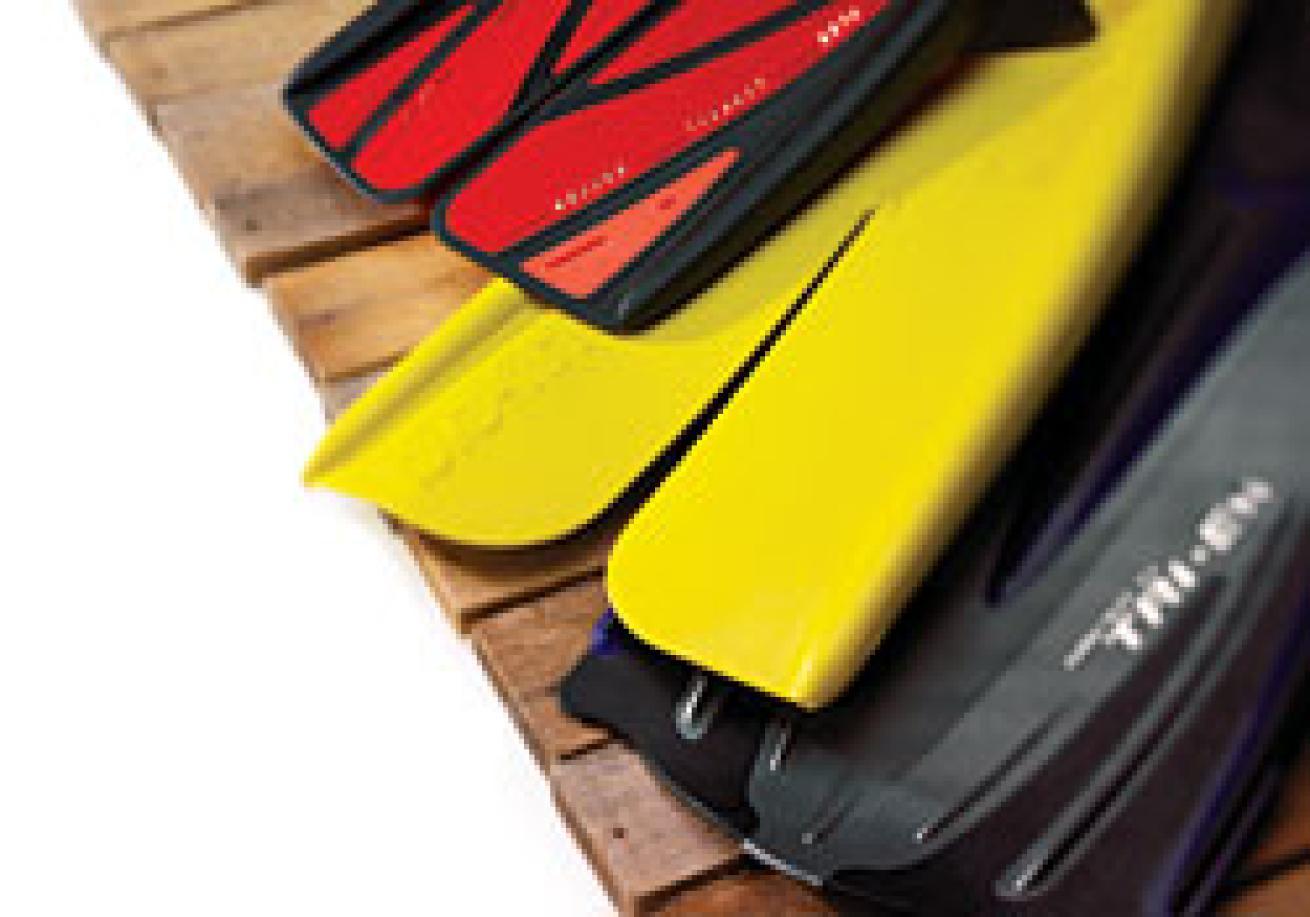
On a balmy afternoon in May, 12 divers loaded down with luggage congregated in Curaçao's Hato International Airport. Scuba Diving's volunteer dive team, called to arms for another round of fin testing, shared hugs and backslaps pent up from a year's separation.
The eight men and four women hailed from California to Virginia, Montana to Texas. Back home, they were computer consultants, software developers, chemical engineers, dive instructors, energy policy analysts, account executives and small business owners. But for the next week they would be test divers. Their mission: to see which of this year's new scuba fins had the right stuff.
By the time the test team arrived at Habitat Curaçao, Anne-Marie Vermeer and the crew at Easy Divers, the resort's dive operation, had our seven crates of fins and test tools cleared from customs and safely stored in her dive training classroom. The dive boat was gassed up, and down in the fill shed both air and nitrox tanks stood ready, waiting for us to get busy.
So that's what we did. While the test divers organized their gear, the Scuba Lab staff laid out the slalom and efficiency courses in the shallows just off the resort, then loaded fresh batteries into the digital underwater speedometers, double-checked stopwatches and strapped waterproof test sheets to underwater slates. By the time the team was assembled on the dive dock, we were ready to collect some data.
Each morning for five days, team members immersed themselves in rigorous speed, slalom and efficiency course runs. Then, after a quick soak in the pool and a hot lunch, they loaded onto the dive boat and headed out to evaluate the fins on afternoon reef dives. By week's end, the team had invested 240 diver hours in morning speed, slalom and efficiency tests and completed 160 afternoon ergo dives. In all, our divers generated more than 225 pages of speeds, times, scores and comments, demonstrating once again that nobody consistently collects as much data, on such a wide variety of fins, as Scuba Lab.
2004 Test Observations
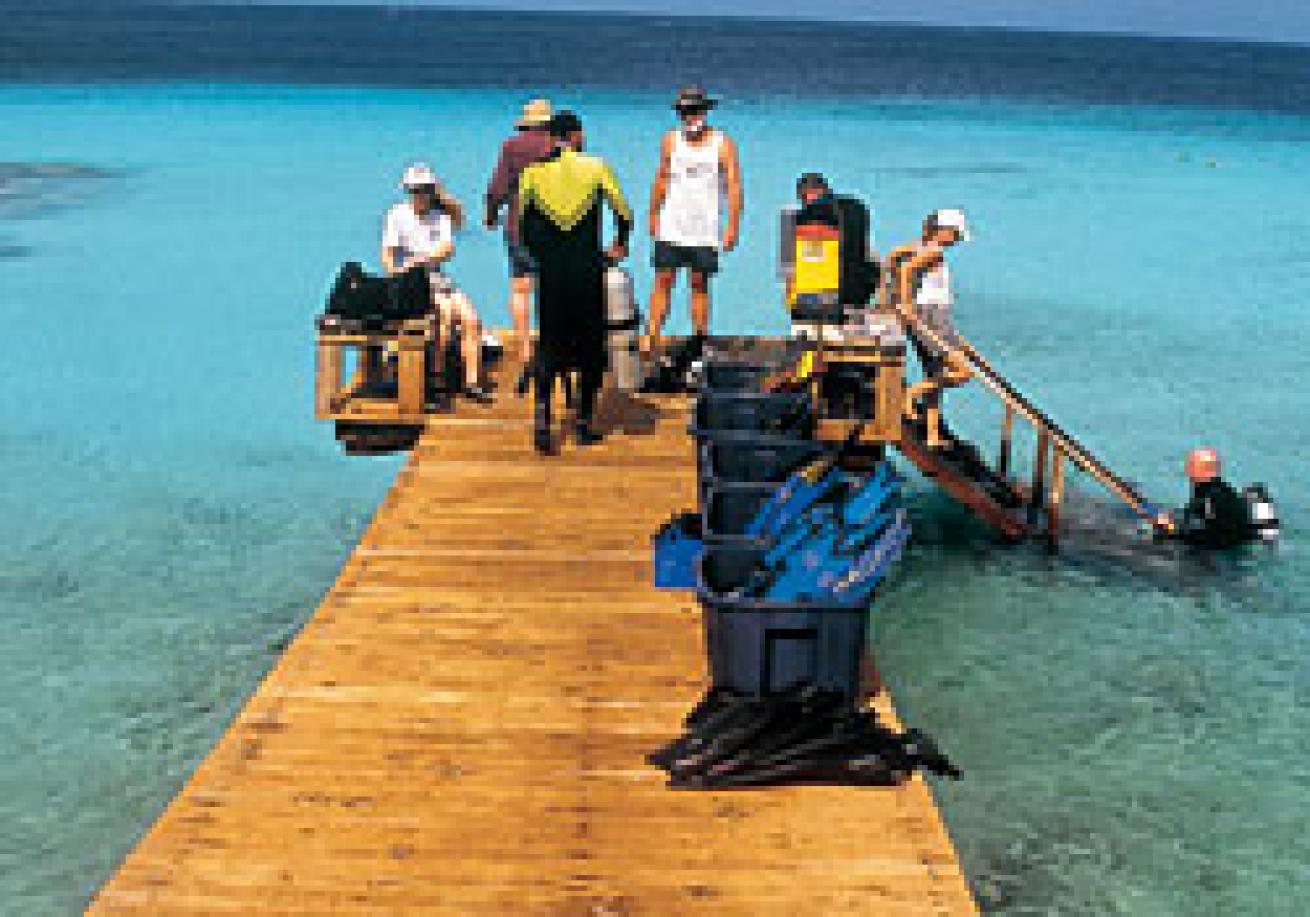
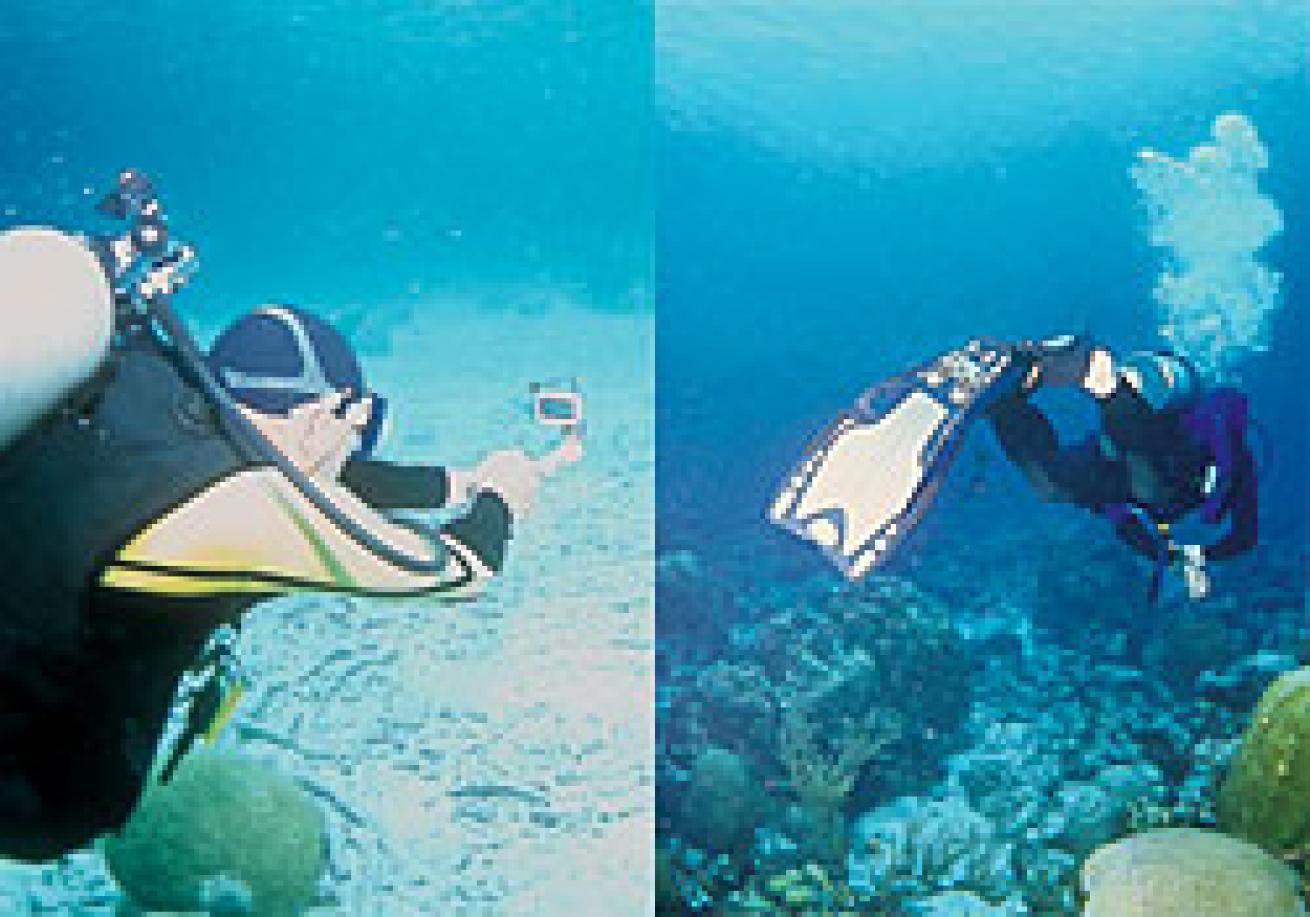
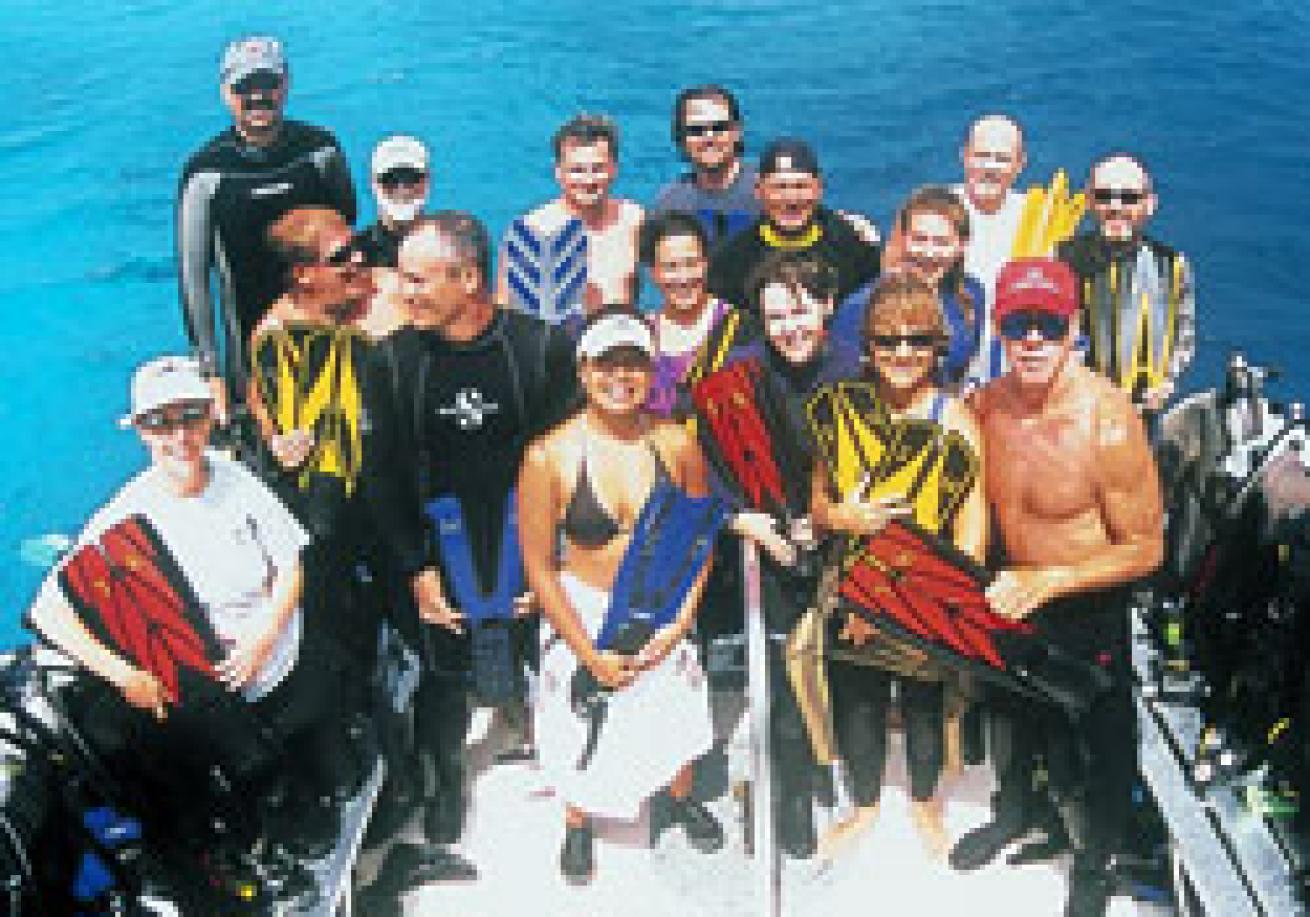
Full-foots are not always fastest. In past years, full-foot fins dominated the speed runs. This year, for the first time, the fastest fin in all speed runs was an open-heel model. While a form-fitting full-foot pocket can play a major role in a fin's efficiency, it doesn't guarantee the gold.
Split fins still rule the seas. Although a few paddle fins are closing fast, split fins still reign supreme when it comes to overall performance--the combination of speed, maneuverability, efficiency and ergonomics as measured in our tests. This year, of the eight Testers' Choices awarded in both open-heel and full-foot categories, six went to split fins.
Speed equals performance. While raw speed isn't everything, our tests clearly show it's a good indicator of a fin's overall performance. For example, the three fastest fins on this year's speed course were also the champs on the slalom and efficiency courses.
We need better buckles. Never in the recent history of fin tests have we had so many buckle disasters, including pins coming out at depth, spring-loaded strap adjustment buttons falling apart on the dive boat and straps snapping on the swim step. And these are new fins. Expensive new fins. A broken buckle or strap can bring a dive to a screeching halt. That's why Scuba Lab thinks fin manufacturers should include at least one spare strap/buckle assembly with each pair of fins they sell.
Behind the Scenes at Fin Test 2004
Fins on. Fins off. Repeat. The Habitat Curaçao dock (top) was fin test central for speed, efficiency and slalom course runs. Test diver Donald Victorian (middle left) measures his top sustained speed with a digital underwater speedometer. On reef dives (middle right), our volunteers evaluated the ergonomics of fins in real-world conditions and (bottom) managed to have some fun, too.
See more photos of the fin testers at work and at play in an exclusive behind-the-scenes report from Fin Test '04. Visit www.scubadiving.com/200410_scubalab_fintestbts.
Open-Heel Fins
2004 Testers' Choices
These six top performers in the open-heel category proved to be fast, maneuverable, stable and capable of quick acceleration.
Apollo Sports Bio-Fin Pro XT/C-Series
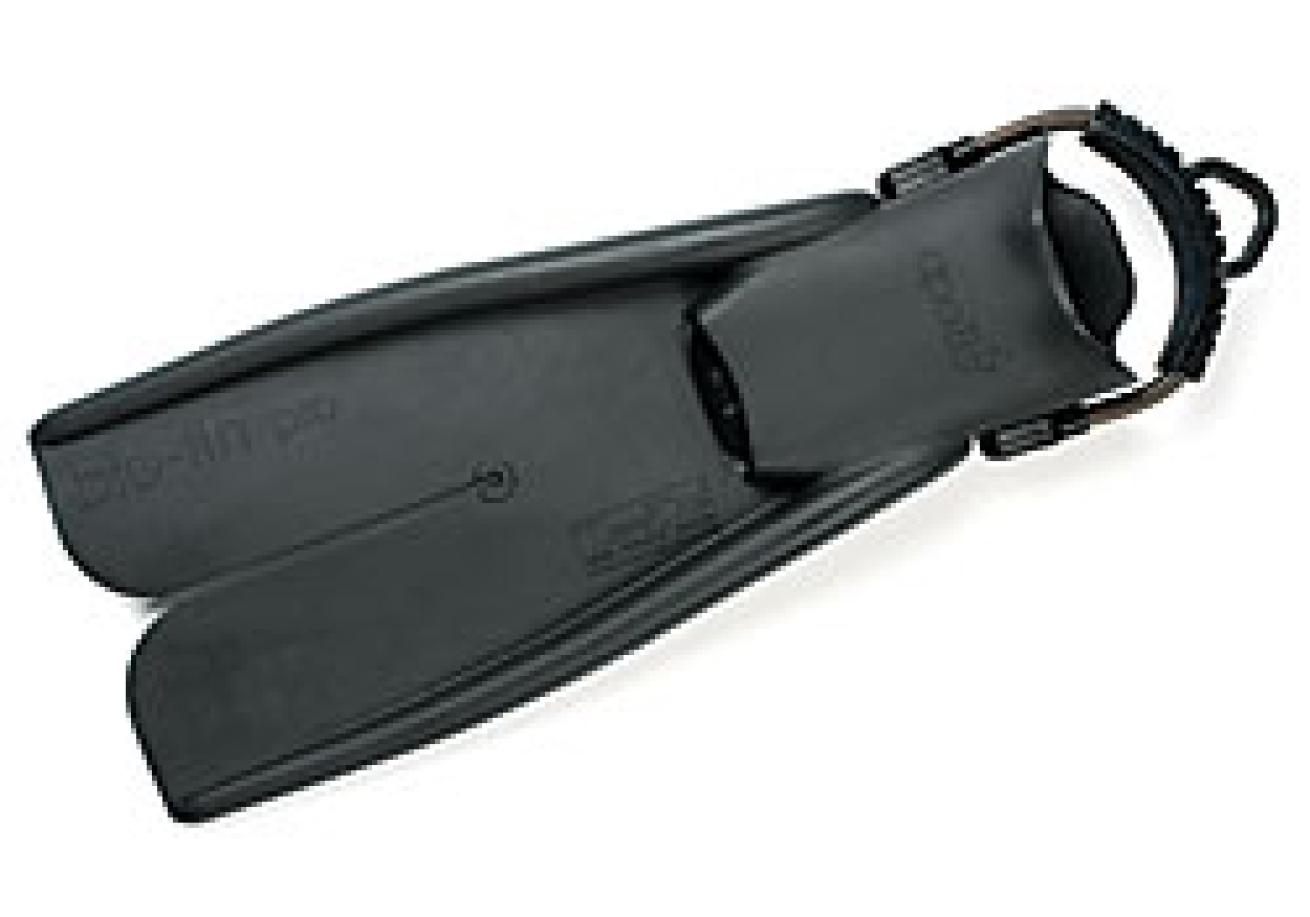
Apollo Sports Bio-Fin Pro XT/C-Series Various models of Apollo's Bio-Fin Pro split fins have dominated Scuba Lab's fin shootouts since 1999. This year it's the Bio-Fin Pro XT/C-Series. The undisputed king on the flutter-kick speed course, the fin also smoked the competition on the dolphin- and frog-kick runs. It was also the fastest fin around the slalom course, and earned the second-highest score for ergonomics. Add it all up and you get one-half of a two-way tie for 2004's best overall open-heel fin.
The XT is identical in appearance to other Bio-Fins. Where it differs is in the stiffness of its blade. Designed for divers who prefer a bit more "feel" to their fins, the XT has a durometer--or stiffness level--of 75, compared to 70 for the new Bio-Fin Pro Yellow (see following review) and 65 for the Bio-Fin Pro Black, one of last year's top open-heel fins.
The C-Series designation refers to the XT's new commercial-grade straps, with built-in stainless steel coil springs and rugged rubber grips. They through-bolt to backing plates on the foot pocket and appear virtually bulletproof. Test divers loved them.
The only complaint about the XT/C-Series was that it's only available in three sizes, and they tend to be cut on the large side. This wasn't a problem for the male test divers, but a few of the women felt left out of the fun when they couldn't find an XT that fit.
Test Diver Comments "This fin is a rocket. Love the strap ... Easy to make small maneuvers. A must-have fin for videographers and photographers ... Great fin! This spring-loaded strap is a revolutionary breakthrough. Very comfortable foot pocket."
Apollo Sports Bio-Fin Pro Yellow
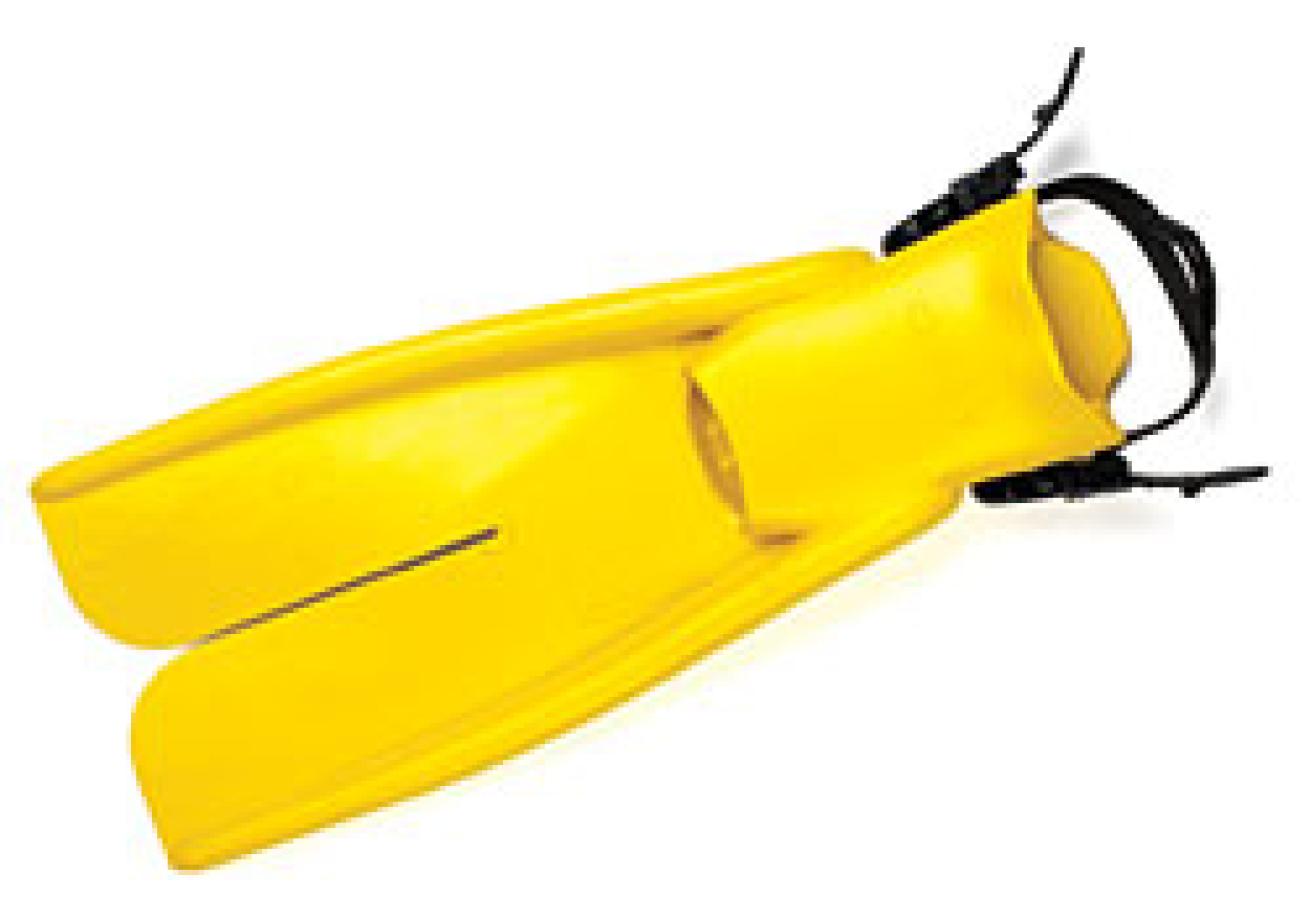
Apollo Sports Bio-Fin Pro Yellow Like its macho XT cousin, the Bio-Fin Pro Yellow is a bonafide speedster, and a real neck-snapper off the mark. One of only two fins rated Excellent in the power vs. stress ergo category (the other was the XT), this is also the only fin test divers rated Excellent for acceleration--the blade is not as stiff as the XT so it tends to have a livelier snap. Stable at high speeds and quick and nimble on the reef, this pliable fin racked up the highest total ergo score in this year's shootout. Combined with a second-best time on the slalom course and the fastest time on the efficiency course, the Bio-Fin Pro Yellow earned the same total overall score as the XT and therefore shares the title of best overall open-heel fin of 2004.
The vibrant color is intended for divers and guides who want to be noticed. And like all Bio-Fin Pros, the Yellow is made of 100 percent natural rubber, which not only contributes to its performance, but also makes for an extremely comfortable foot pocket. The fin comes in an additional smaller size that female test divers really appreciated.
Test Diver Comments "Powerful, yet comfortable--it virtually form-fits to your foot ... Zero resistance at high speeds. A real go-fast fin ... Great nonskid--these fins aren't going anywhere on deck ... Great pickup from a dead stop ... A fine choice for sprinting after wayward barracuda."
Atomic Aquatics Reef Red
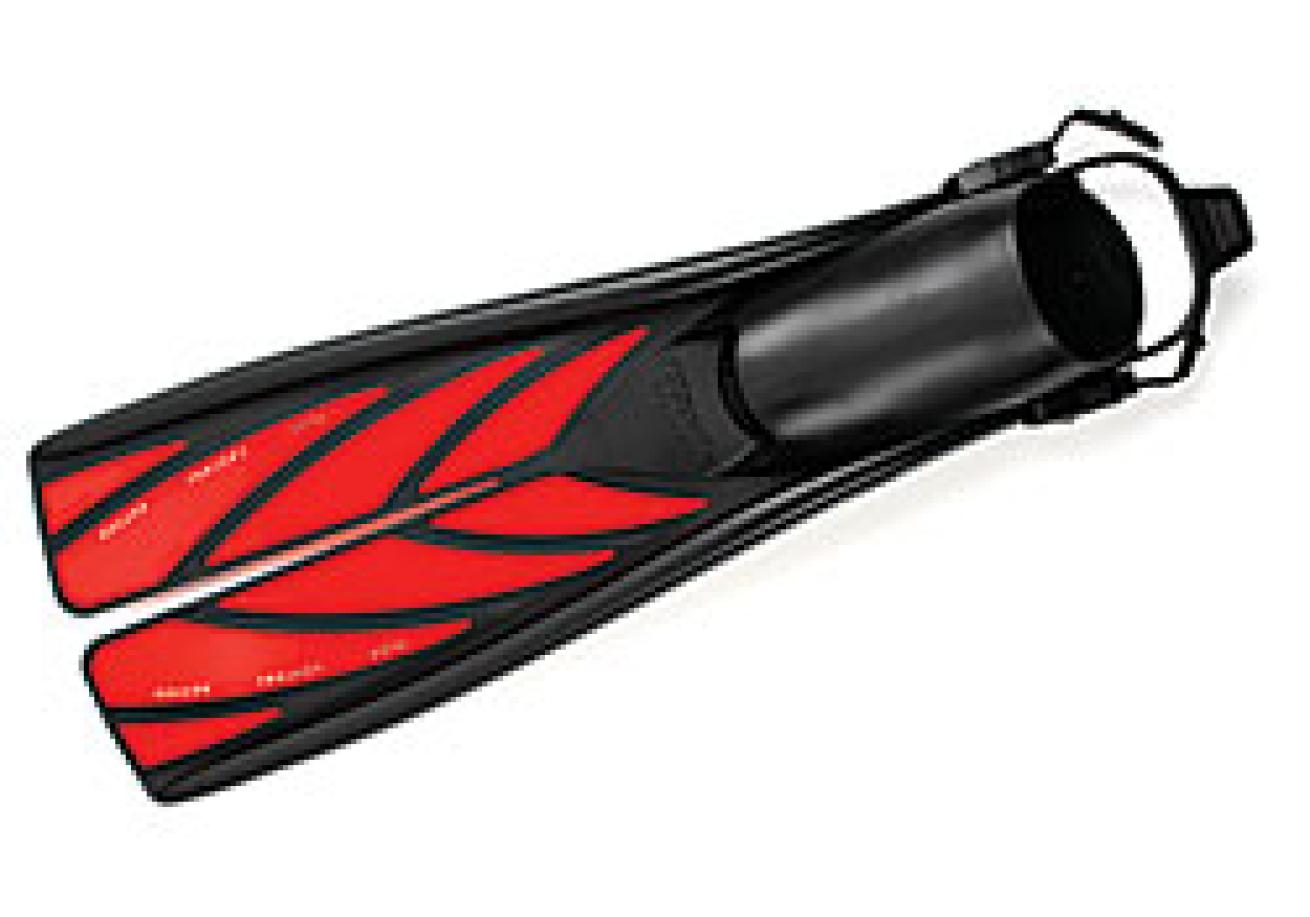
Atomic Aquatics Reef Red This latest version of Atomic's sturdy SplitFin gets its name from the bright red flexible panels on its split blade. According to Atomic, the fin's base material is similar to last year's Liquid Blue, but has an added ingredient that increases elasticity over previous SplitFins. It's also lighter than its predecessors.
Like earlier SplitFins, the Reef Red sports a longer-than-average blade--the longest split fin blade in this group. In spite of its length, the fin easily scoots around underwater corners. The tight turns of the slalom course were conquered just two seconds shy of the front-runner XT's best time, and the fin ran neck and neck with the XT on the efficiency course. On the speed course, the Reef Red heats up the water, regardless of fin kick, but it really showed its stuff on the ergo dives. It's powerful yet stable when streaking through blue water, and easy to control down among the corals.
The Reef Red was rated Excellent for donning and doffing thanks to the EZ-Lok buckles. To detach, you simply squeeze both tabs and slip the buckle off the post. To attach, slide it onto the post where it clicks into place. For the past three years, the EZ-Lok has been rated the best buckle system by test divers.
Test Diver Comments "They're like Mercury's winged boots ... Nice-fitting foot pocket. Good all-around performance ... Best buckle of the group ... Everything I want--power, agility, speed. I just love these fins."
Mares Volo Power
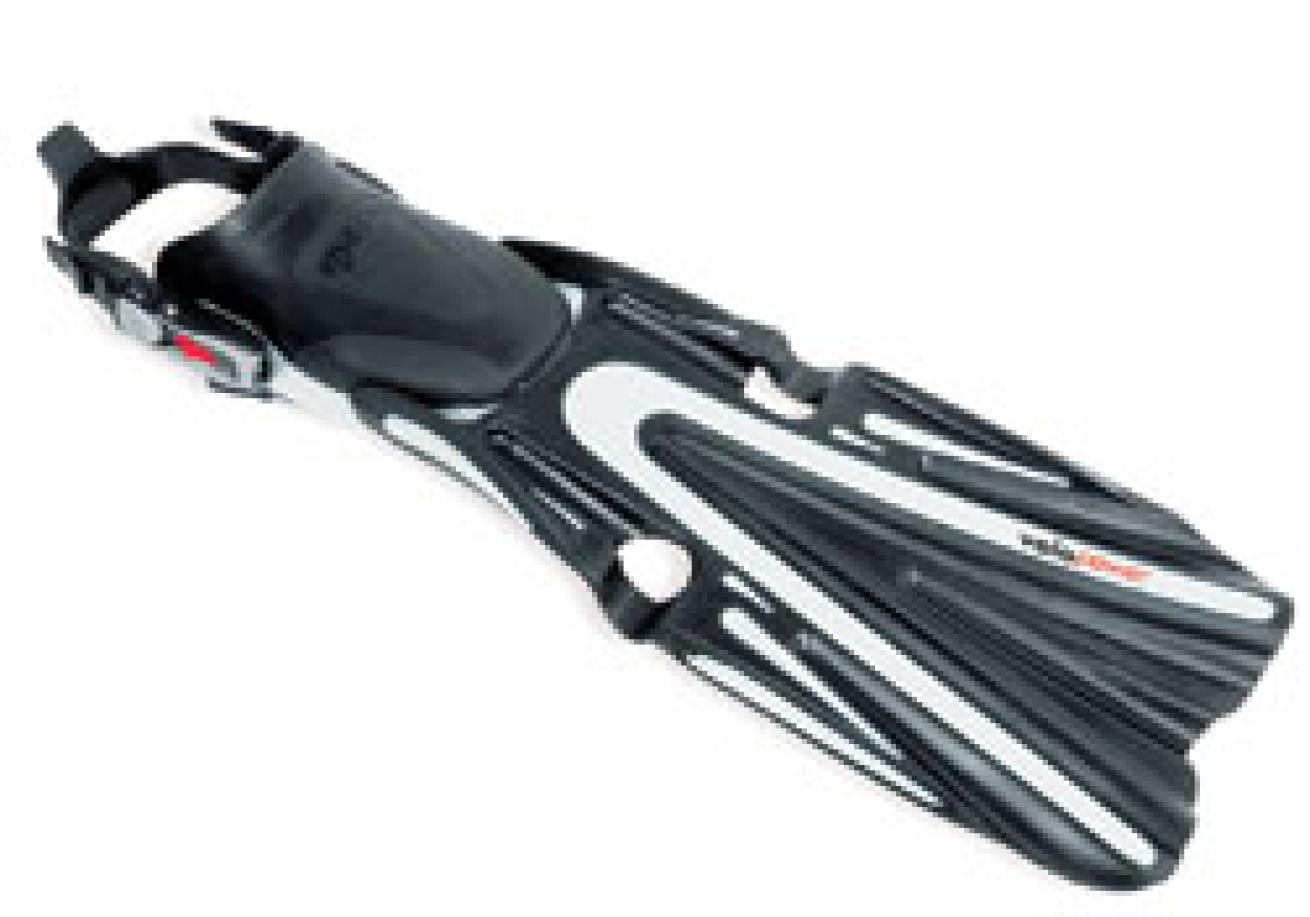
Mares Volo Power The Volo Power is an updated version of the popular Volo. According to Mares, the Volo Power uses more Channel Thrust than its predecessor. This is a water channeling system that helps the blade increase thrust. Like the original Volo, the Volo Power uses Mares' patented Optimized Pivoting Blade, a hinge-like design that allows the blade to angle itself into the ideal shape for forward thrust.
In the water, the Volo Power is relatively fast, stable and highly maneuverable. It responds well to both long and short flutter kicks when you're going for speed. When you're exploring reefs, the fin will easily get you in and out of nooks and overhangs. Test divers also found the bootie-hugging foot pocket very comfortable.
The Volo Power is fitted with ABS (Adjustable Binding System) buckles. These are hinged closures with a sliding button that can be locked (although it's difficult to tell when it's locked and when it's not). Test diver descriptions of this system ranged from "clever, but complicated" to "infuriating." Luckily, the strap adjustment button works quite well, so if you find the buckle system too frustrating, you can simply loosen the strap to put on and take off the fin, thereby avoiding the buckle system altogether.
Test Diver Comments "Comfortable foot pocket, but too many latches and locks ... Powerful fins--lightweight and comfortable in the water ... Very maneuverable in tight spaces. Buckles are a problem ... My favorite paddle. Lightweight. Nimble."
Tusa Imprex Tri-Ex
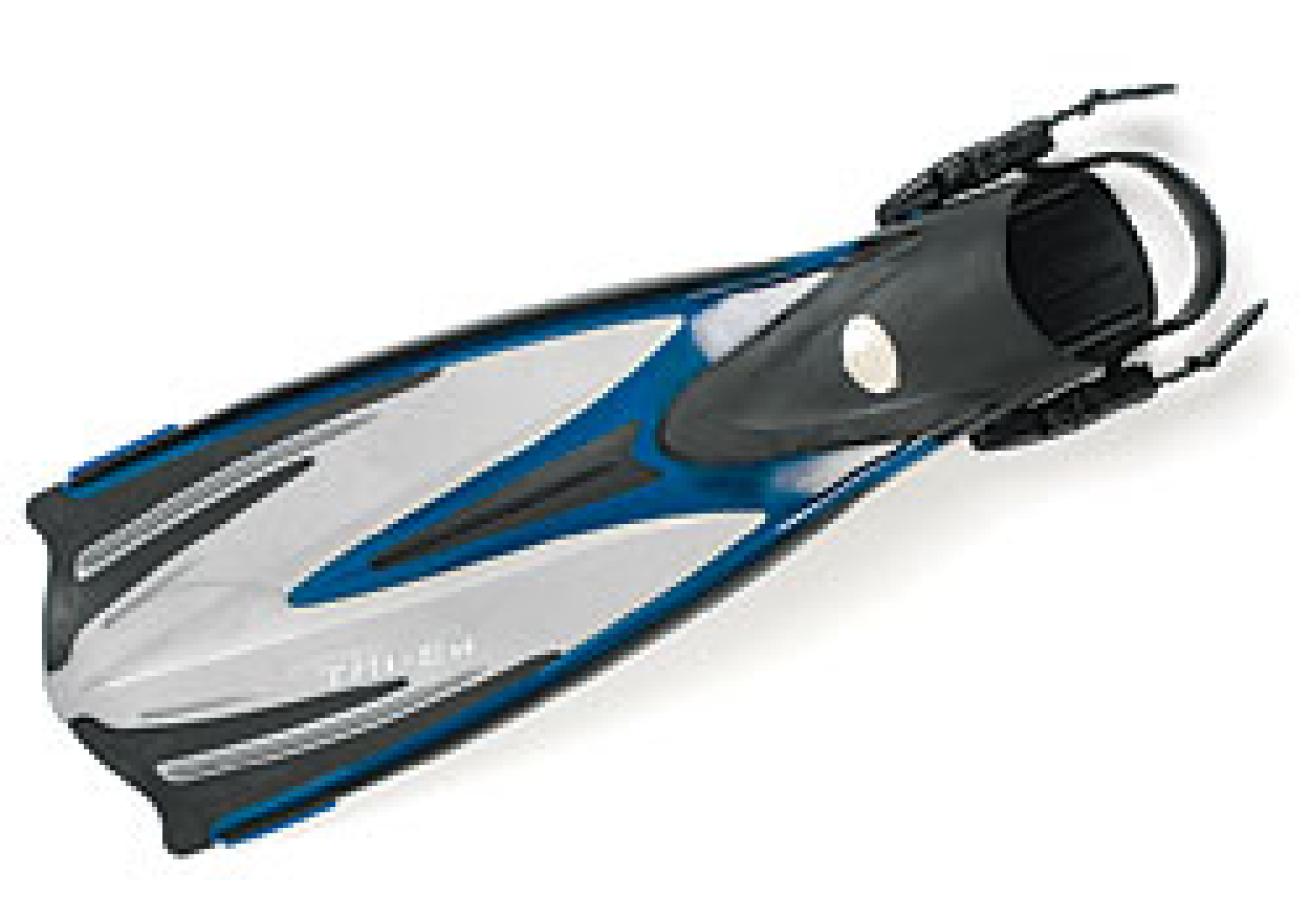
Tusa Imprex Tri-Ex Tusa's new Tri-Ex gets its name from the fin's three distinct materials: the super hard I-beam side-rib, the medium-hard blade and the soft pocket. It's one of the few fins to position its foot pocket fully beneath the blade, which has a roughly 20-degree bend to it.
The Tri-Ex is lightweight yet powerful. While not as fast as the other Testers' Choice fins using the standard flutter kick, it can keep up with the Volo Power and Reef Red using the frog kick. Overall, it's one of the best paddle fins. Only the Volo Power beats it, and just barely at that.
On the reef, this fin is a go-getter. The rigid rails provide above-average stability--there were no reports of side slice or wobble. Test divers also reported that the fin provided an efficient top-water kick back to the dive boat. Most divers rate it a comfortable fin, though some female divers found it difficult to get a good fit.
Bonus: The Tri-Ex carries one of the lowest price tags--just $89, making it not only a Testers' Choice but also a Best Buy.
Test Diver Comments "Lovely feel to this fin ... Easy to back up ... Except for my too-small foot being able to wobble in the too-large foot pocket, this fin was a pleasure to dive ... Nice blade fins, stable, balanced. I like them ... The response of this fin in current is excellent. The design seems to deliver more energy on the downstroke."
Aeris Velocity Duo
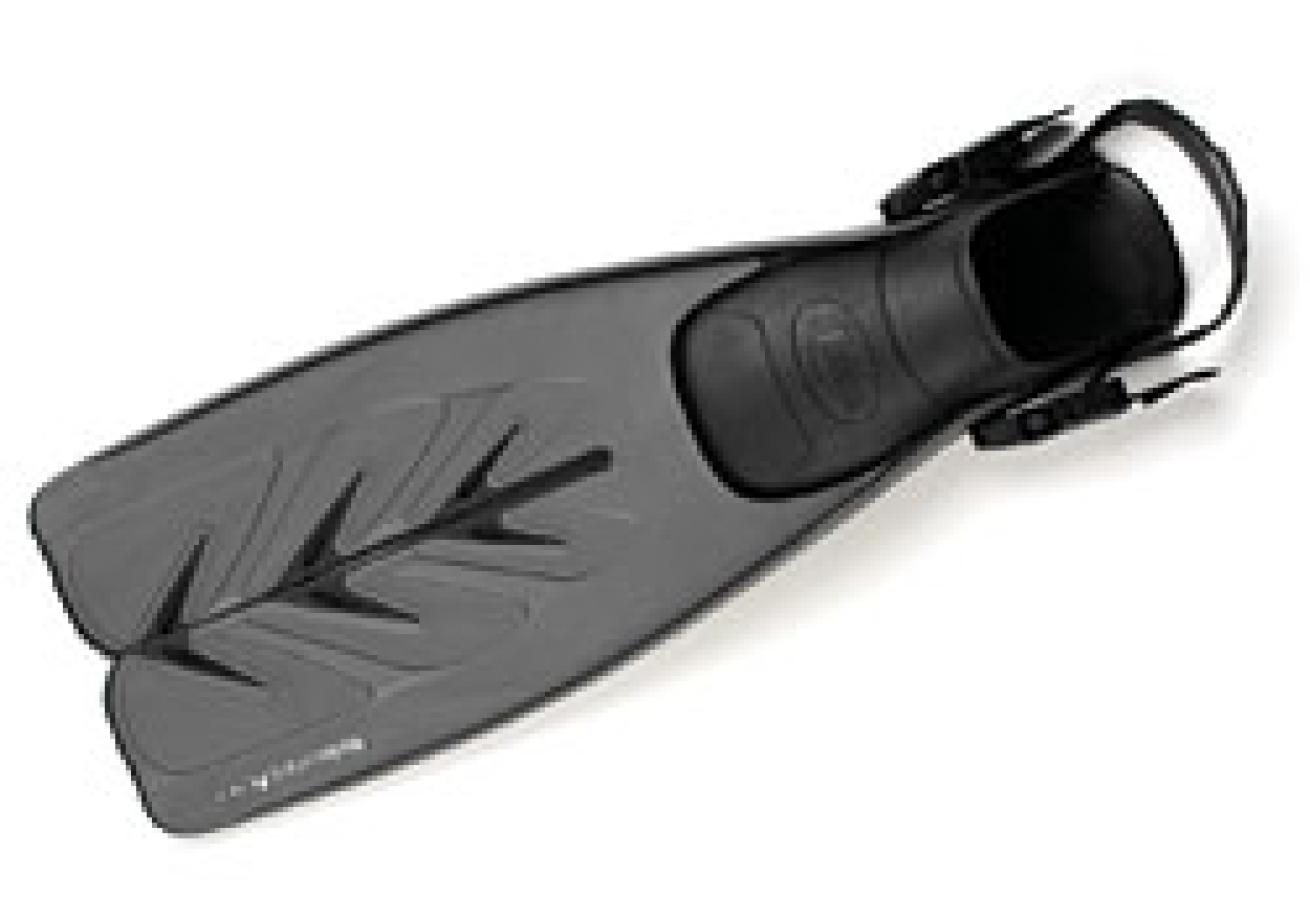
Aeris Velocity Duo Aeris leaps into the split-fin market with its new Velocity Duo. According to the company, the fin was designed to provide greater thrust while reducing muscle fatigue. The dual blade design allows the diver to deliver a much more efficient flutter kick, thus reducing the amount of effort needed for forward propulsion.
Speed-wise, the Duo is nothing to write home about. Although it has good acceleration, it tops out relatively quickly. It is, however, a very nimble fin. It was able to negotiate the tight turns of the slalom course better than most, and kept up with the best of them on the efficiency course.
It's in real-world diving conditions that the Duo shows its stuff. Considered a nice all-around reef fin among test divers, the Duo is stable when pumping against a current, maneuverable when ducking around reefs and responsive at lower speeds.
The Duo is by far the lightest of this year's open-heel split fins (it weighs barely two-thirds as much as the Apollo XT/C-Series), making it extremely easy on the feet. It's also this year's least expensive split fin.
Test Diver Comments "A very nice all-around reef fin ... Fins have a tendency to touch ... Fin feels really light on the feet for a split ... Decent leisurely fin, but not my choice for speed ... Nice kick--not too hard, not too soft."
Very Good Performer
Although the Response didn't earn enough points to earn a Testers' Choice designation, it nevertheless delivered above-average performance in many ergo categories, including stability, maneuverability and comfort, as well as on the efficiency course.
Genesis Scuba Response

Genesis Scuba Response The Response is a paddle fin with a bit of split-fin technology in its design. The blade is built with rigid oblong-shaped discs divided by narrow composite rubber channels and a flexible center panel. According to Genesis, this patented flex pattern develops a channeling effect to increase thrust.
While not a particularly fast fin using the flutter kick, the Response holds its own with the frog kick and is most effective using the dolphin kick. Like Tusa's Tri-Ex, the Response touts its use of three different materials to provide both performance punch and increased comfort. It's one of this year's lightest open-heel fins and comes with a nice foot pocket. The fin won kudos for fit and comfort among all test divers, but female divers seemed to really like the Response, not only for its comfort but because it's an easy fin to maneuver as well as to control at depth.
It's a good all-around fin with above-average performance, all at a bargain suggested retail price of $75. In our book, that warrants a Best Buy recommendation.
Test Diver Comments "Light and agile ... This fin felt really stable in the water ... I was very comfortable diving in these fins ... Very easy to kick for a paddle fin ... Comfortable fin, but you won't catch too many eagle rays with it ... A very nice fin for practical recreational diving."
Good Performers
These fins delivered respectable performance in the ergo tests, with the F-14 Thruster excelling in straight-line stability, the Impact excelling in alternate kicks, and the Mach II Turbo and Magnifica excelling in donning and adjusting for fit. On speed and slalom courses, performance ranged from Fair to Good.
H2Odyssey F-14 Thruster

H2Odyssey F-14 Thruster The F-14 Thruster is a big fin. It's heavy when compared to most other paddle fins and has the longest blade in this year's test group. It's made of polypropylene plastic blade halves molded to a center thermoplastic rubber panel for a webbed effect. While it's not real fast swimming a straight line, it is very stable. That is, until you put it into slalom mode, then the big fin tends to be hard to control in the turns. The foot pocket is very comfortable, but is available in just two sizes.
In spite of all this, test divers were kind of fond of the Thruster. The middle-of-the-road performance was sufficient in a real-world diving context, and at slower speeds the fins behaved relatively well. Combine that with some very good nonskid and a suggested retail price of only $59.95, and you've got a fin that grows on you.
Test Diver Comments "Stable and smooth, but a little squishy in the turns ... Fins are comfy, but not speedy ... Decent power for the effort. A little hard on the ankles, but not bad."
Sherwood Scuba Impact
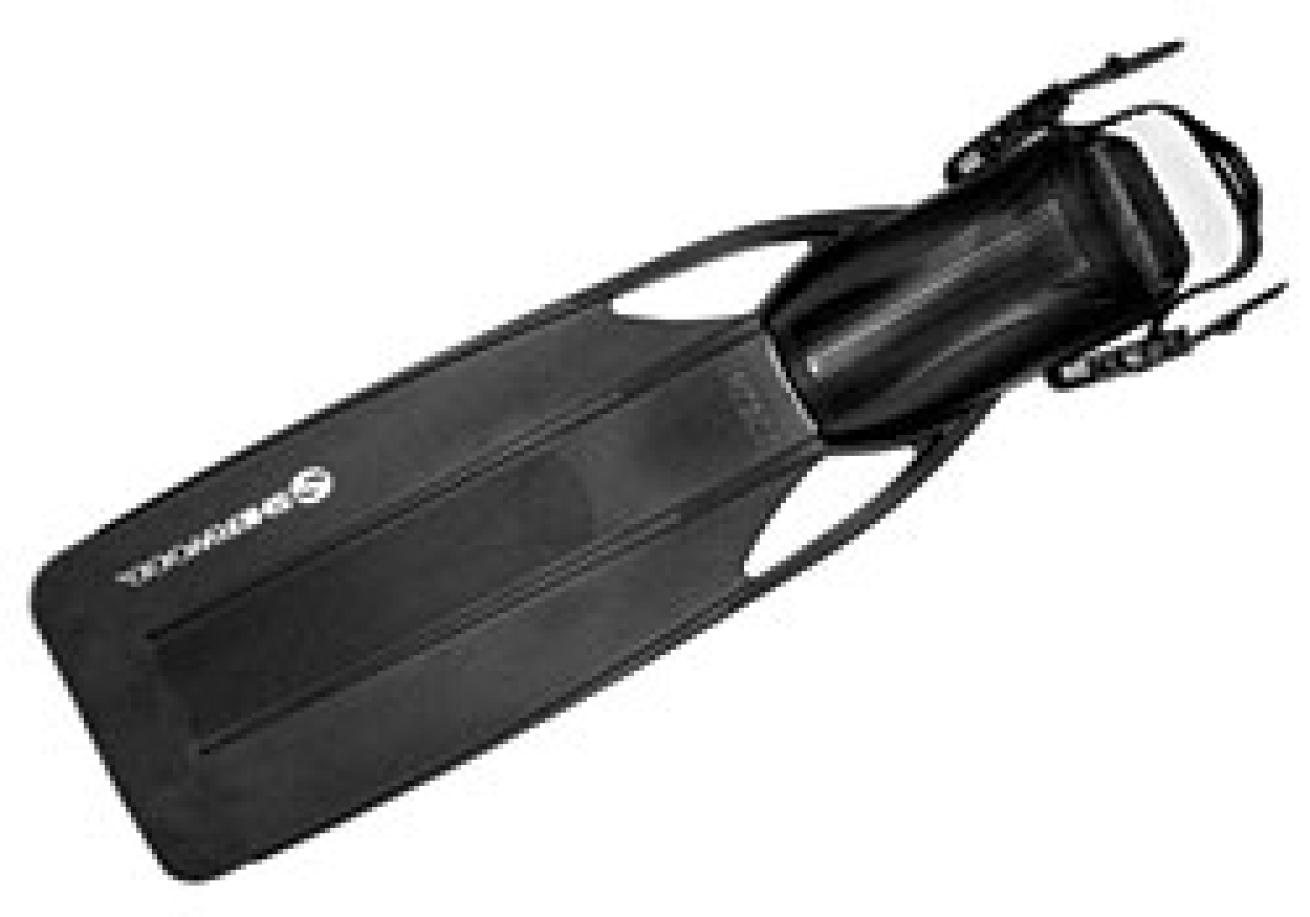
Sherwood Scuba Impact The Impact has a long, wide, traditional-style paddle blade made of reinforced EVA synthetic rubber. While not particularly fast or maneuverable, it can be an efficient cruising fin once you get a sense of its size and behavior.
Its big, flexible blade seems to respond best to a wider, more traditional flutter-kick stroke. It also tends to be an easy fin for doing slow and easy frog and dolphin kicks. Most female test divers had problems controlling the big blade and dealing with ankle stress, but most male divers found the fin to be comfortable.
Test Diver Comments "You have to kick these fins slow and methodical to appreciate them ... Started my dive not too impressed. Ended the dive kind of liking these big fins ... Ankle-busters. Too much effort required ... Using a slow, steady fin stroke, I could wear them all day."
H2Odyssey/Tilos Mach II Turbo
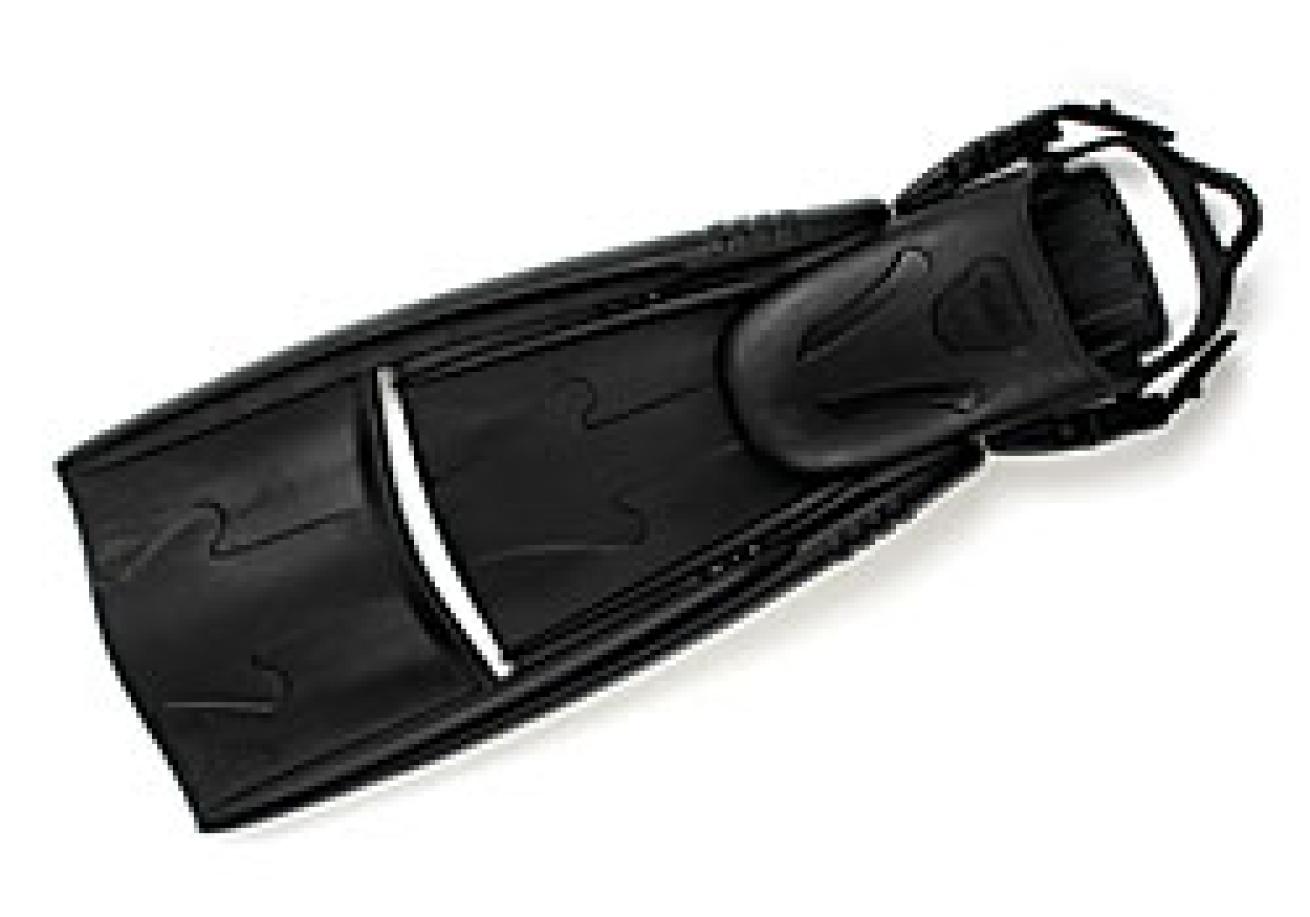
H2Odyssey/Tilos Mach II Turbo The Mach II Turbo, available from both H2Odyssey and Tilos, is this year's most unusual fin. It is designed with a horizontal flap in the main body of the blade that's supposed to stabilize each kick while providing additional thrust.
Based on our speed tests, the thrust part isn't working out so well. Nicknamed the "Bat-Fin" by test divers, this heavy fin generated relatively low speeds regardless of kicking style, then came in dead last on the slalom course. While the flexible fins allowed for quick cornering, once around the tight turns it was just hard to get moving again.
The Mach II Turbo blade has variable-thrust Power Tabs so you can customize the stiffness. But even in its most rigid mode it was still an extremely pliable fin. The fin is easy to put on and adjust, but several test divers found the foot pocket to be too short and too wide, creating unwanted wobble.
Test Diver Comments "I kick, but just can't seem to go anywhere ... Comfy kick, but not much thrust ... Buckles adjust like butter ... Virtually useless at slow speeds ... Loose center blade has a mind of its own ... Hey, you gotta give it a 10 for looks."
Tilos Magnifica
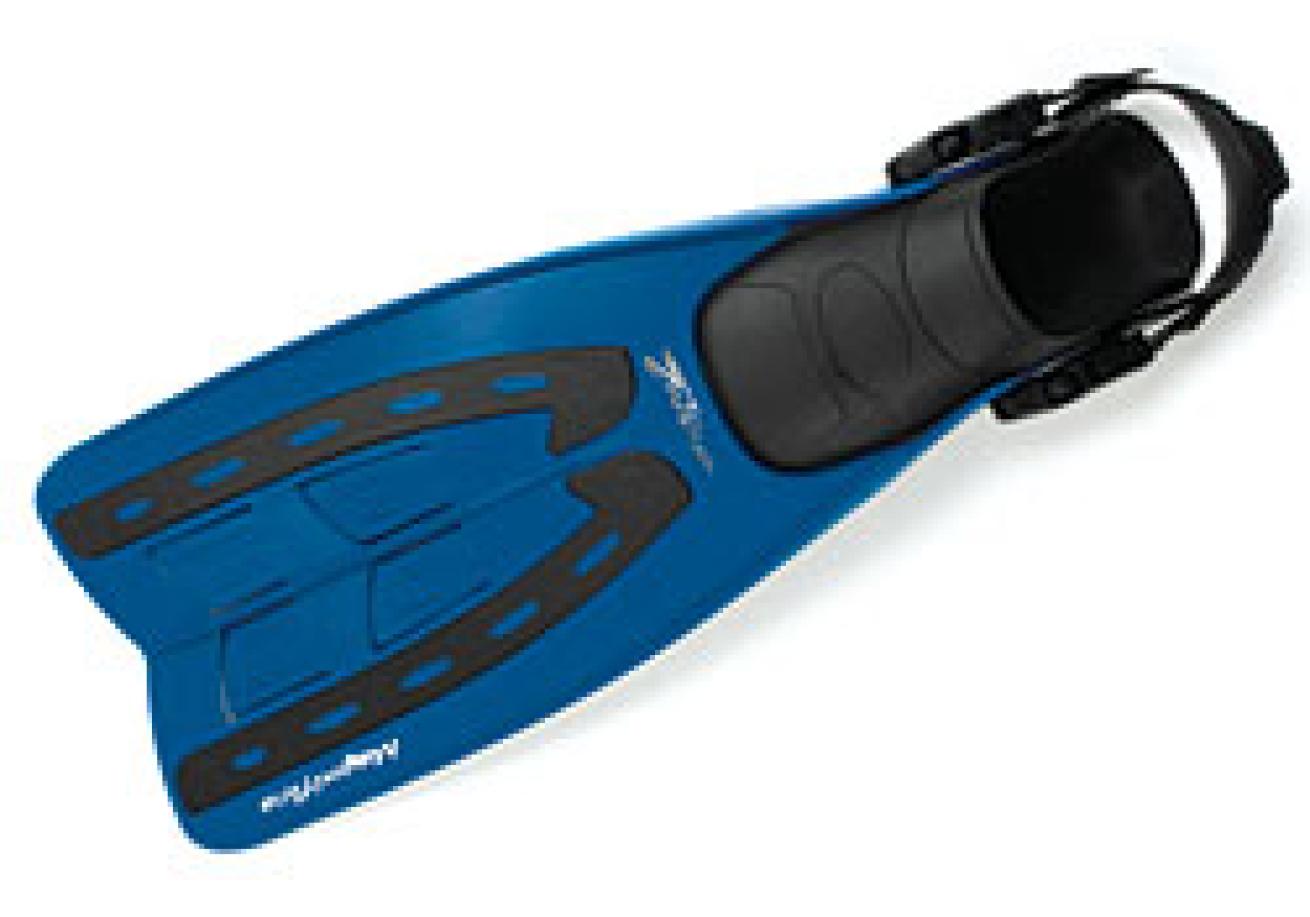
Tilos Magnifica The Magnifica is very similar to the Aeris Velocity Duo in shape, size and pocket design. But whereas the Velocity Duo opted for the split-fin concept, the Magnifica took the traditional paddle blade route, then modified it slightly by cutting two pairs of flapping tabs along the centerline. Unfortunately, this design strategy didn't propel the fin down the path of the Velocity Duo's much superior performance. It is, however, an easy fin to put on and take off, it adjusts well, and its nonskid pads are effective on a wet boat deck.
Test Diver Comments "Uninspiring ... Nothing spectacular ... Not bad for just cruising, I guess ... An extremely average fin."
Fair Performer
While the Razor delivered respectable across-the-board ergo performance, its recorded speeds and times on all other tests were never able to rise above the Fair range.
Scubapro Razor
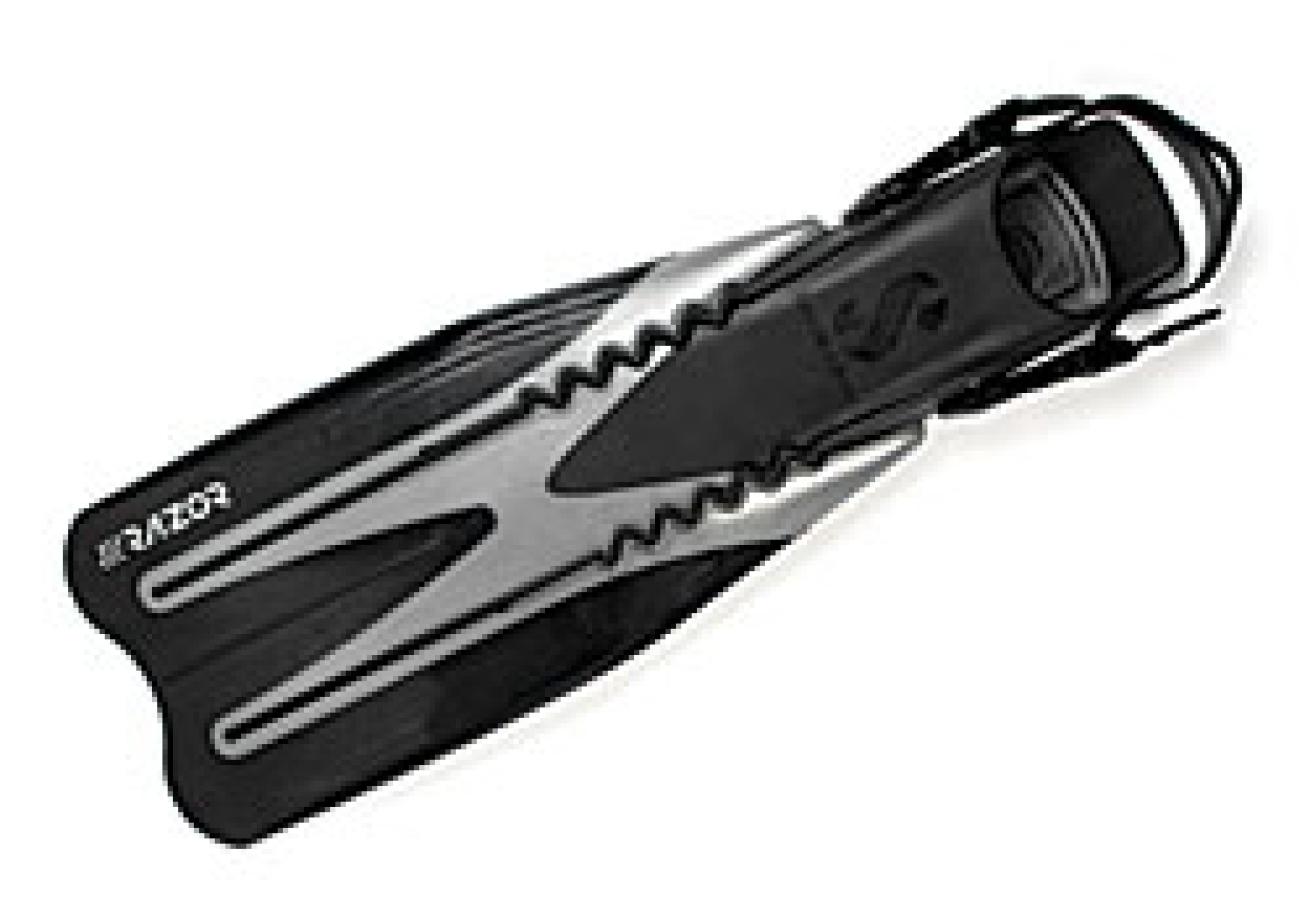
Scubapro Razor On the dive boat, Scubapro's Razor attracts admiring glances. It's a very stylish fin with zigzag spring ribs and side winglets on a rakishly angled two-tone blade.
But get the fin in the water and all those "ooohs" quickly melt into "ugghs." In speed, slalom and efficiency tests, the Razor consistently scored among the slowest fins. Test divers rated it Good across the board in ergo tests, but that wasn't enough to save the Razor from being the lowest-scoring open-heel fin in this year's test.
Test Diver Comments "Really disappointing ... Hard on legs when going for speed ... Be careful on the deck, these babies slide! ... Hard to turn. Hard to accelerate. A mediocre fin ... They're hard on the ankles, but they look cool."
Full-Foot Fins
2004 Testers' Choices
These two fins ran virtually neck and neck in all course runs and nearly all ergonomic categories. However, the X-Pert Zoom FF-9 held a slight edge over the Full-Foot SplitFin in maneuverability.
Tusa X-Pert Zoom FF-9
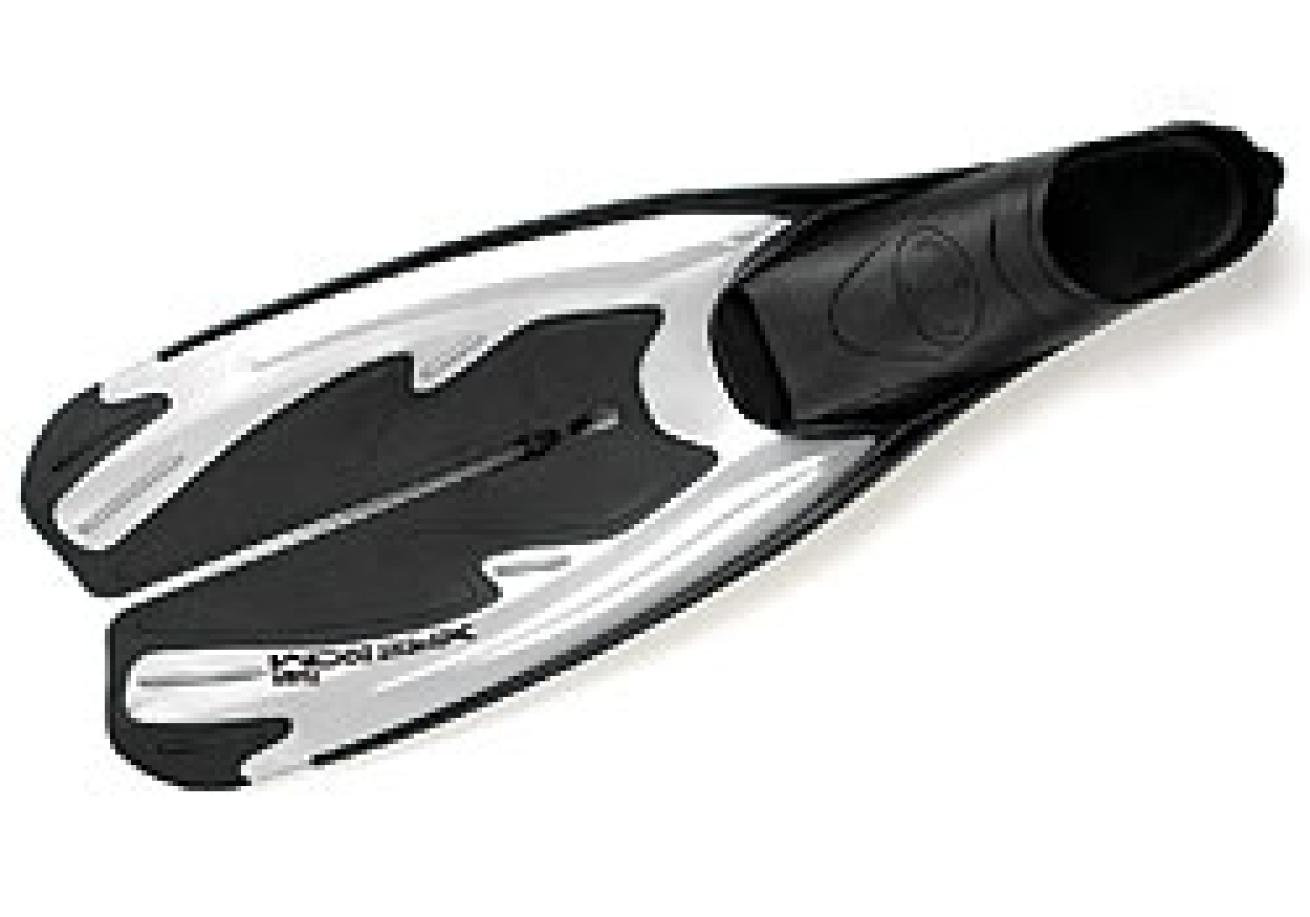
Tusa X-Pert Zoom FF-9 At first look it's easy to underestimate Tusa's new X-Pert Zoom FF-9. Combining split-fin technology with a multiflex blade system, the fin's short, flat blade is lightweight to be sure, and its simple foot pocket is comfy. But beyond that, what more is there to say?
Plenty, once you get the FF-9 into the water. This unimposing fin not only burned up the speed course, running neck and neck with Atomic's new Full-Foot SplitFin, but it also turned heads on the slalom course, then went and edged out all its competition in ergonomic tests, earning the title of best overall full-foot fin of 2004.
The FF-9 is not only top-end fast, it builds speed easily while remaining rock-steady. But agility is really its strong suit. This fin is able to dart in, out and around reefs with the slightest kick. It was the only fin, full-foot or open-heel, that test divers rated Excellent for maneuverability.
Tusa only sent us four of the six available sizes, which prevented some larger test divers from getting a comfortable fit (as indicated by the following comments), but we're convinced that having the two additional sizes at the time of testing would have eliminated sizing problems.
Test Diver Comments "I love this fin! It has speed, it's easy to maneuver and it's so comfortable ... Light and easy to maneuver, but needs a bigger size ... A nice, lightweight fin. Perfect for reef diving ... This is such a terrific fin. So versatile. So graceful. So much power."
Atomic Aquatics Full-Foot SplitFin
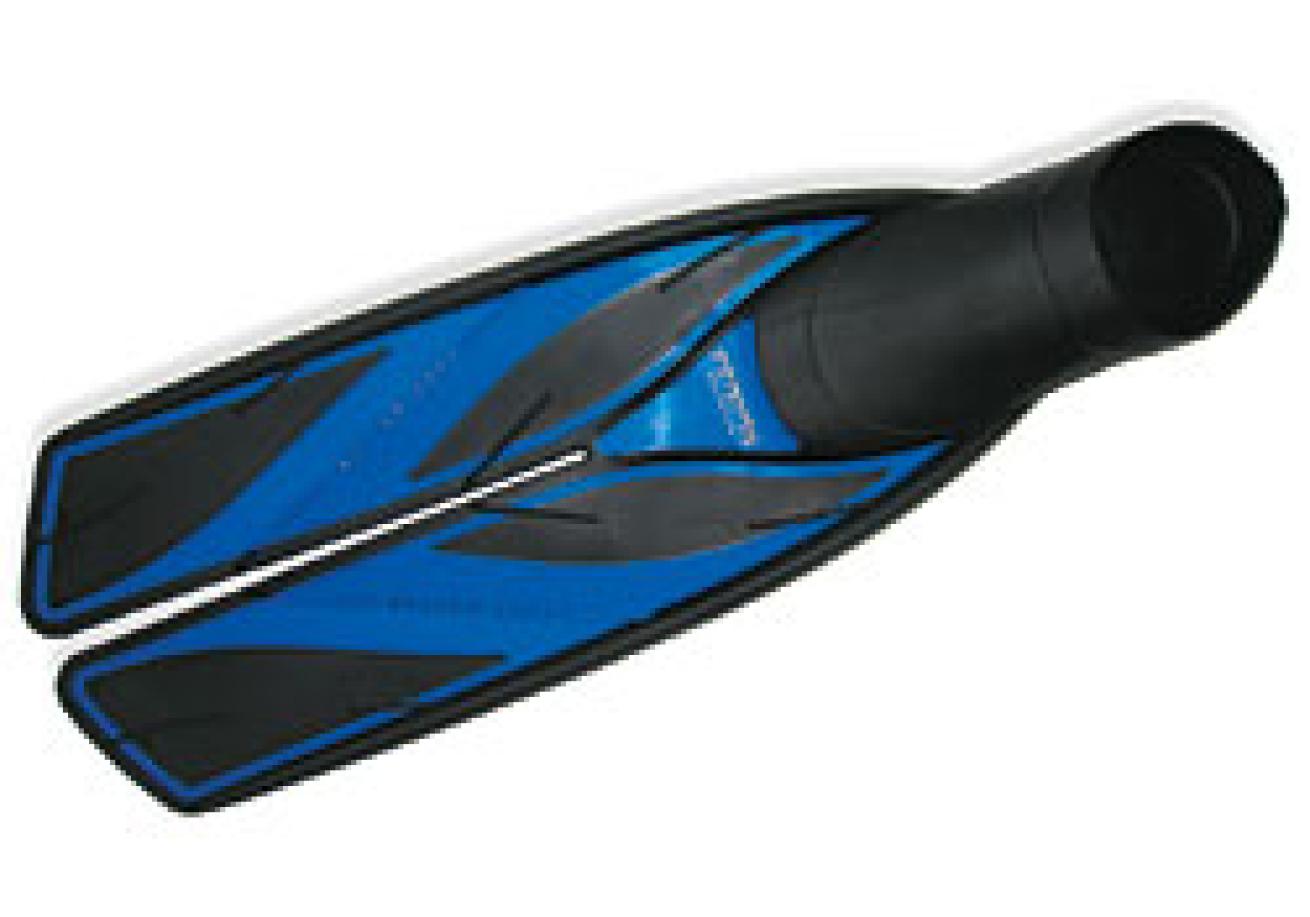
Atomic Aquatics Full-Foot SplitFin The much-anticipated full-foot version of Atomic Aquatics' successful SplitFin is finally here, and it does not disappoint. The fin has a narrow blade with an attractive batten design that allows the fin to offer a relatively stiff blade while maintaining its light weight. Unlike the other full-foots in this year's go-round, there's a pronounced downward sweep to its blade, contributing to its rep as this year's most stylish fin.
But it's not just another pretty face. The fin is a rocket using the flutter kick, and one of this year's fastest fins using the frog kick. In real-world diving conditions, the Full-Foot SplitFin is quick and agile, able to perform those delicate moves required for working close to reefs, or to torpedo through blue water to chase eagle rays.
The only problems test divers had with this fin arose over fit and comfort. The heel tab had a tendency to dig into some divers' Achilles tendons, and due to the limited sizes available (three) at the time of testing, it was hard for some divers to achieve a decent fit. However, since the tests, Atomic has doubled the number of sizes available.
Test Diver Comments "This split fin moves a lot of water with very little effort ... Great pickup! Great stability! ... Boy, these are graceful. The perfect reef fin ... Fin feels light and comfortable in the water. Good flexibility."
Good Performer
Like the Good open-heel fins, this full-foot fin delivered respectable performance on the ergo course, with acceptable times and speeds turned in on slalom and speed courses.
Tilos Feather

Tilos Feather Weighing in at just under a pound, this modified paddle design is the lightest fin in this year's round-up. While probably better-suited to snorkeling, the Feather delivered decent performance on the speed course. It also earned a higher rating for fit and comfort than any of its competitors. The foot pocket is very soft--good for comfort, but bad for efficient energy transfer. Plus, the overly flexible blade had a tendency to fold up in tight turns. But for a suggested retail price of only $37, this isn't a bad fin.
Test Diver Comments "Folds up like tissue paper when hit hard ... I have no control over these fins ... Speed--forget it. Agility--forget that too ... Comfortable. No foot or ankle strain ... Very lightweight, but no power."
A Universal Fin Strap
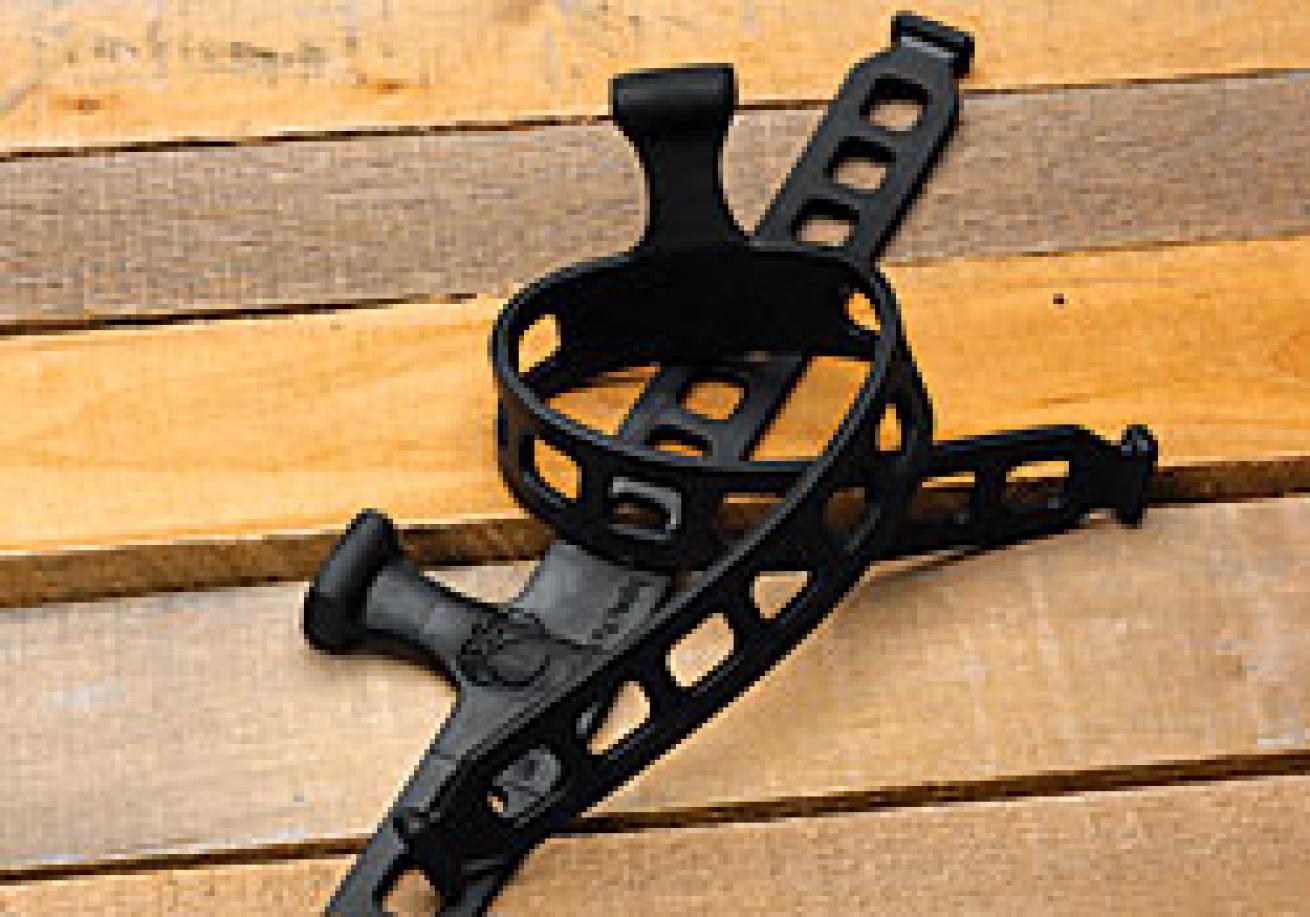
Universal Fin Strap If fin manufacturers aren't willing to include a spare buckle/strap assembly with each pair of fins they sell, here's another way to prepare yourself for a buckle or strap disaster. This universal fin strap is easy to use (no assembly required), eliminates the need for buckles and changes out in seconds. Simply remove your old fin straps and buckles to expose the fin buckle posts on the sides of the fin pockets. Pick a slot in the strap and pop it over the post. With the large, easy-to-grab pull tab, you slip the strap up 0n your heel and, just like that, you're ready to resume your dive. We've used this strap on numerous occasions, and it's as easy to use as it claims. Available in two sizes, you probably want to lean toward the shorter strap: too long and it might leave too much strap end flapping in the current. For use with most post-1990 fins. Price: $9.95 a pair. See your local dive store or contact DeepOutdoors, the distributor, at (866) 867-7739 or [email protected].
Missing in Action
All fin manufacturers were invited to participate in this year's review. Here is a status report on the major manufacturers who are not represented.
Aqua Lung and Zeagle did not have any new scuba fins listed in their 2004 catalogs, so they were not able to participate in this year's review.
Beuchat, Cressi-sub and IST all have new (or previously unreviewed) fins listed in their 2004 catalogs, but they did not respond to our invitation. Due to their limited U.S. distribution, we chose not to purchase their fins for review.
Dacor submitted its redesigned Panther open-heel fin, but we eliminated it from the review when the company discontinued the fin this summer.
Scubapro didn't respond to our invitation. But since there is always huge interest in anything this company makes, we bought a full size range of its new Razor fin.
Oceanic's 2004 catalog shows a full-foot version of their Vector fin that, oops, we didn't notice until after the tests were completed. Not submitting the fin was an oversight on Oceanic's part as well. We did review the Vector open-heel version in last year's review.
Past Fin Reviews
Still looking for the perfect fin? Past Scuba Lab fin reviews are available online at www.scubadiving.com/fins.
Our Thanks

Our 2004 fin test was the smoothest one yet, thanks to our host resort Habitat Curaçao and the on-site dive operation, Easy Divers. The Scuba Lab team and our volunteer test divers would like to thank everyone at the resort and the dive shop for going above and beyond to make our stay easy while we gave these fins a hard time. For more information on Habitat Curaçao, visit www.habitatcuracao.com.


